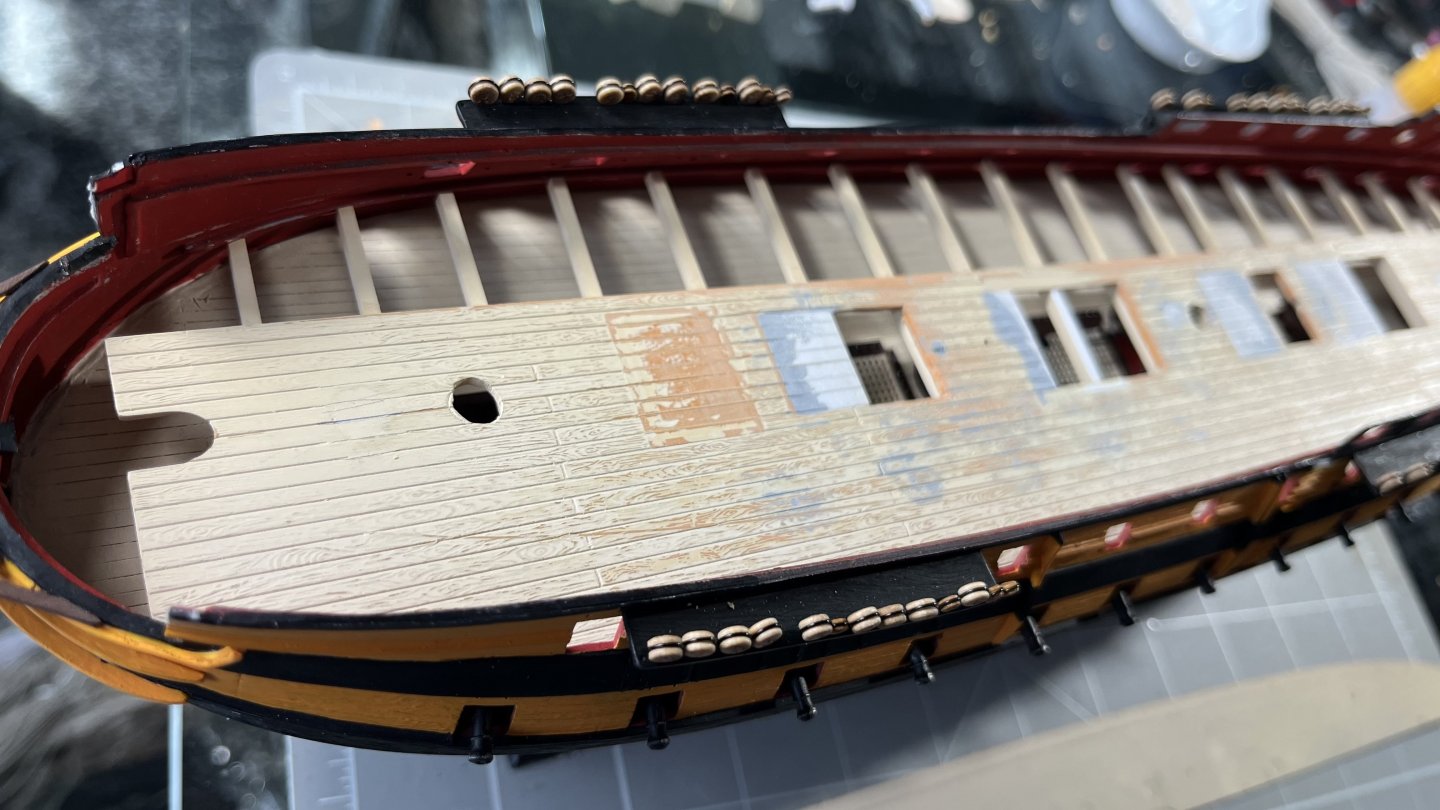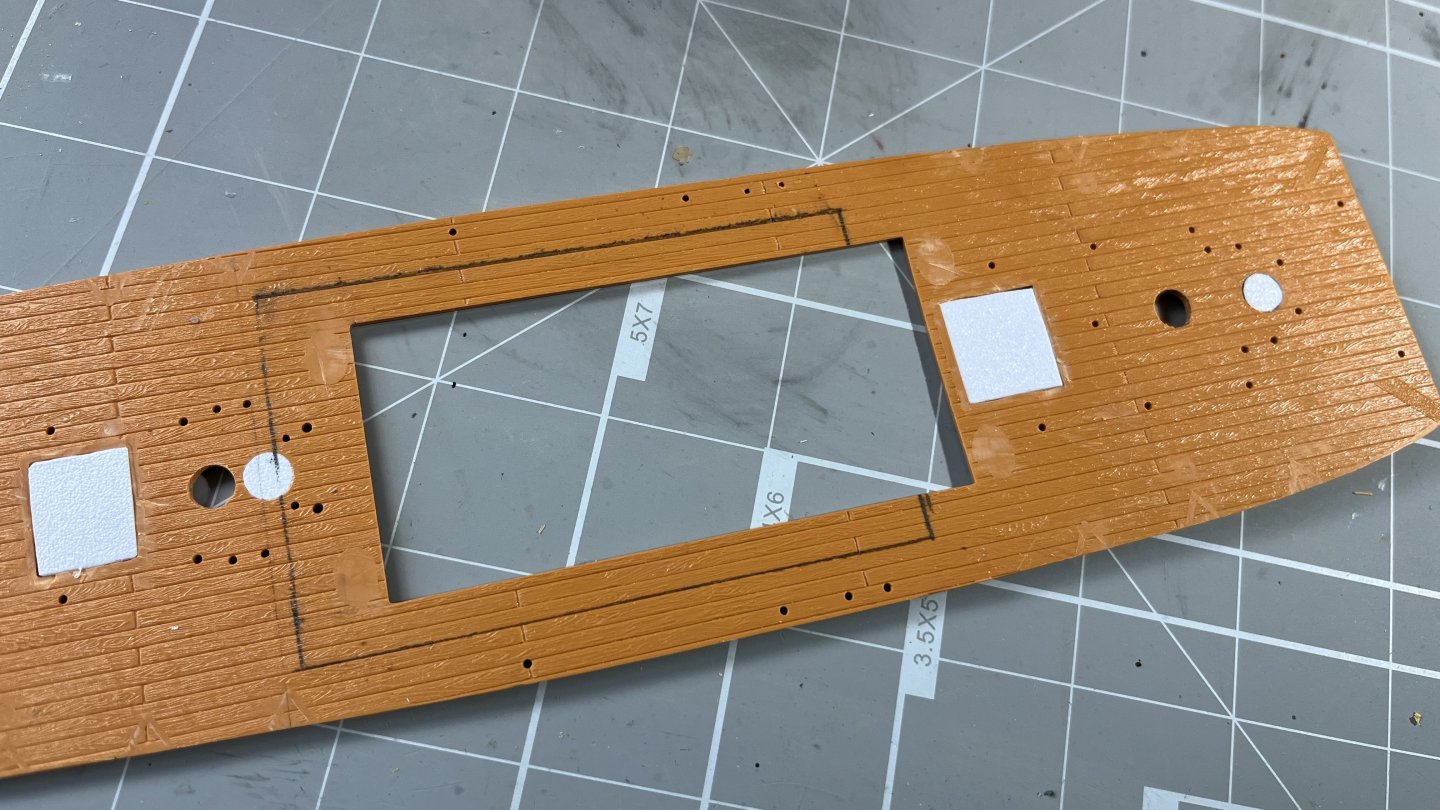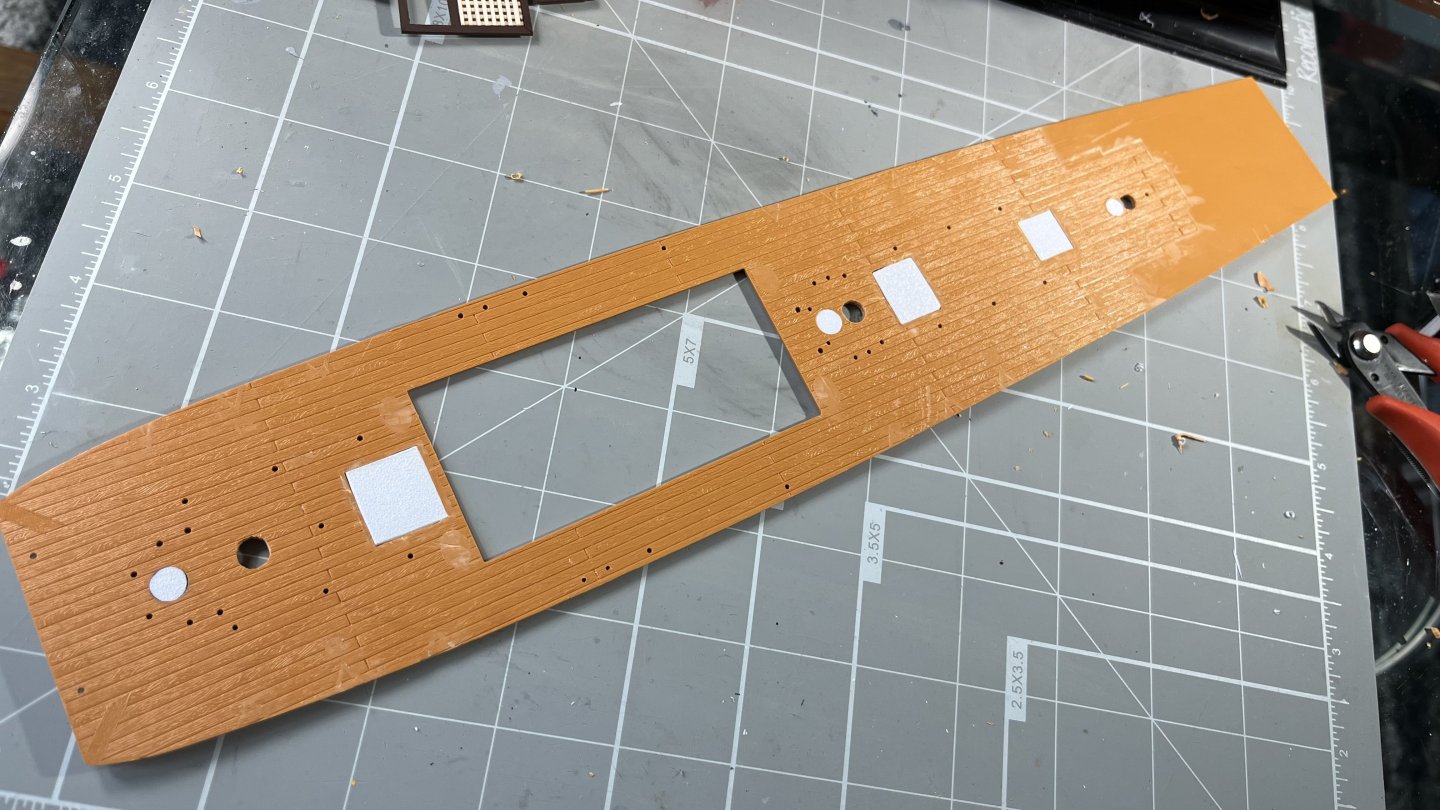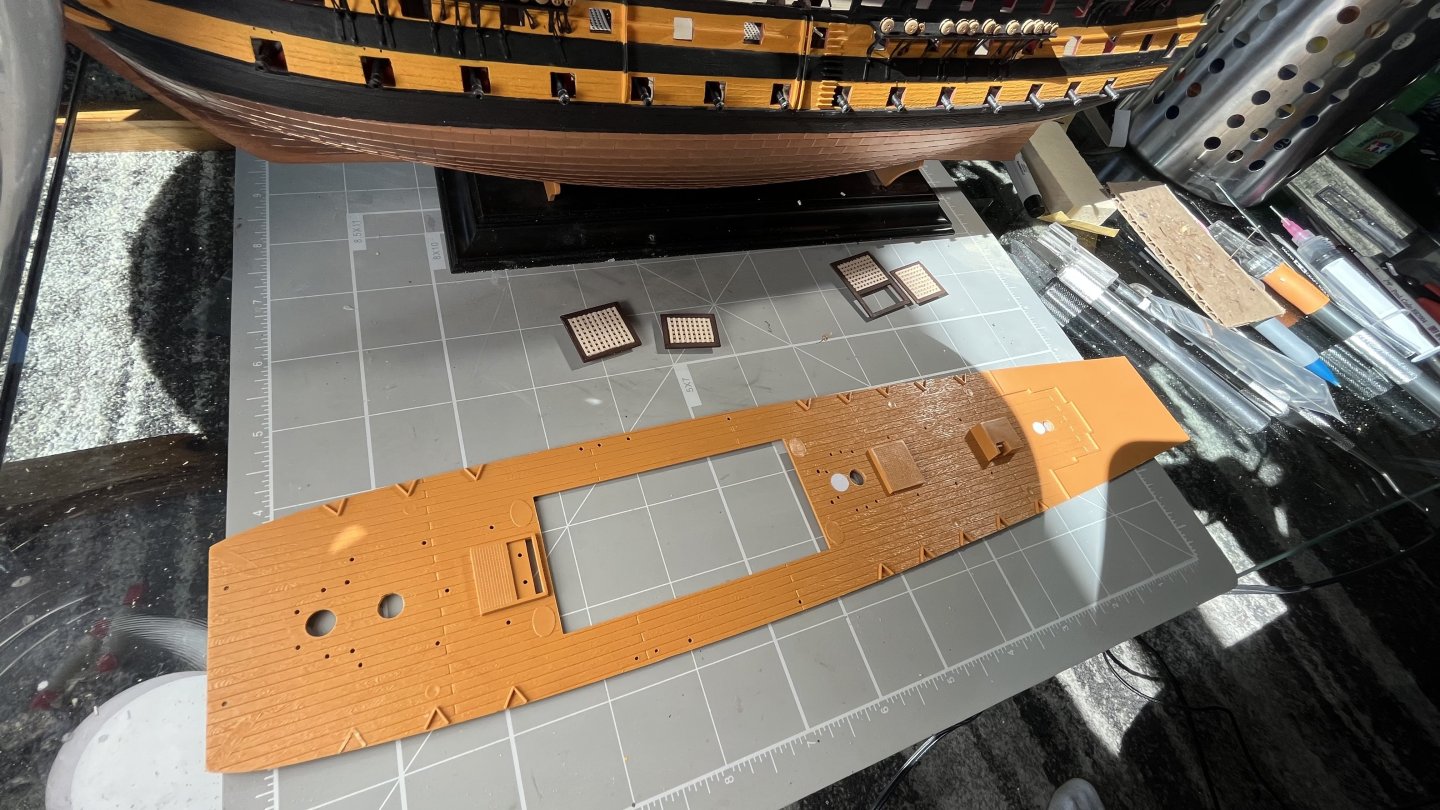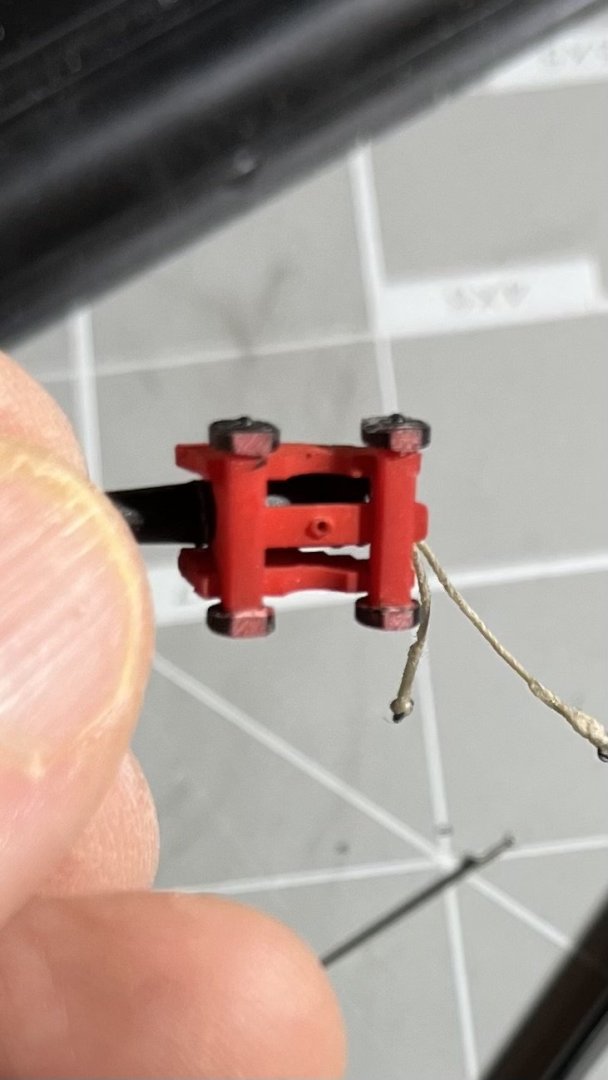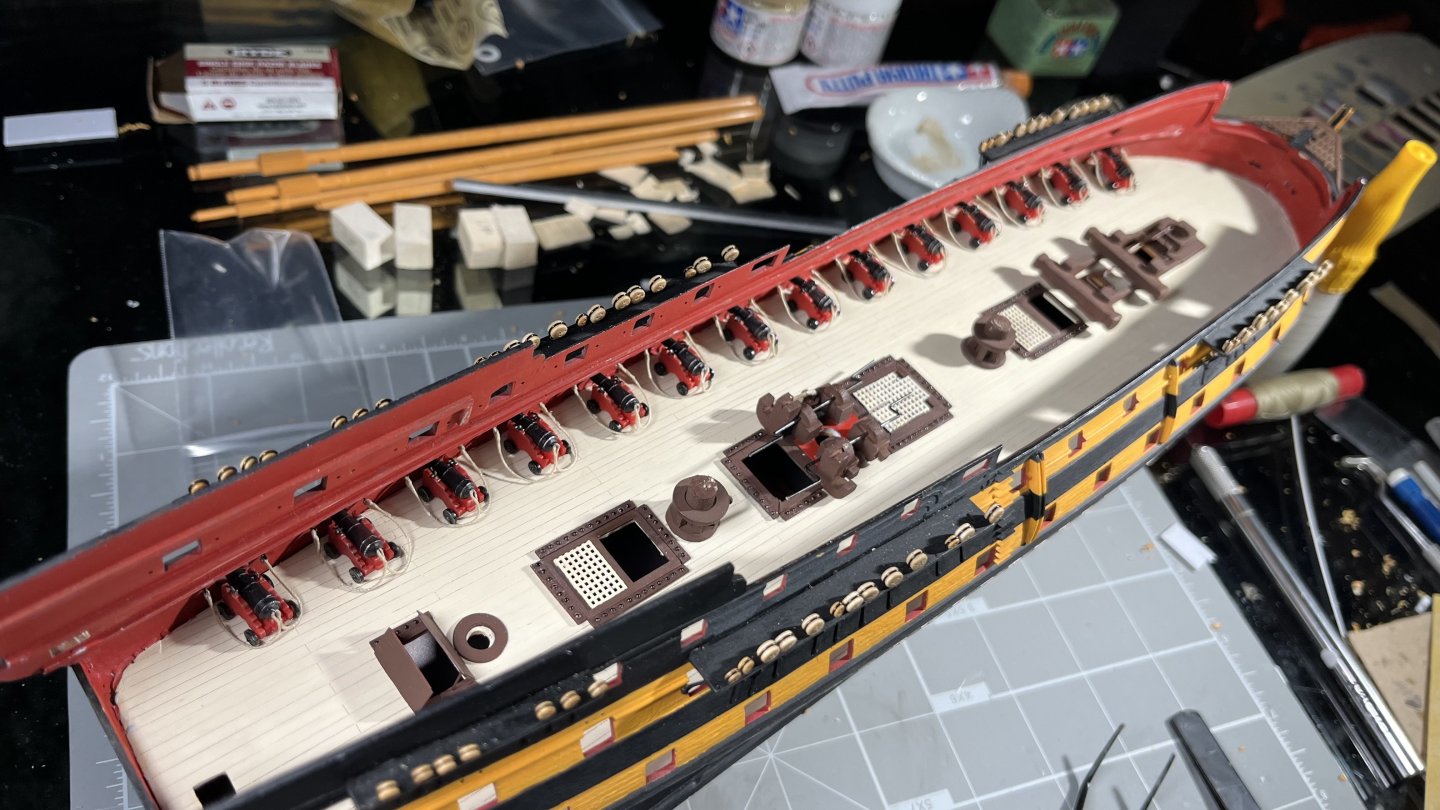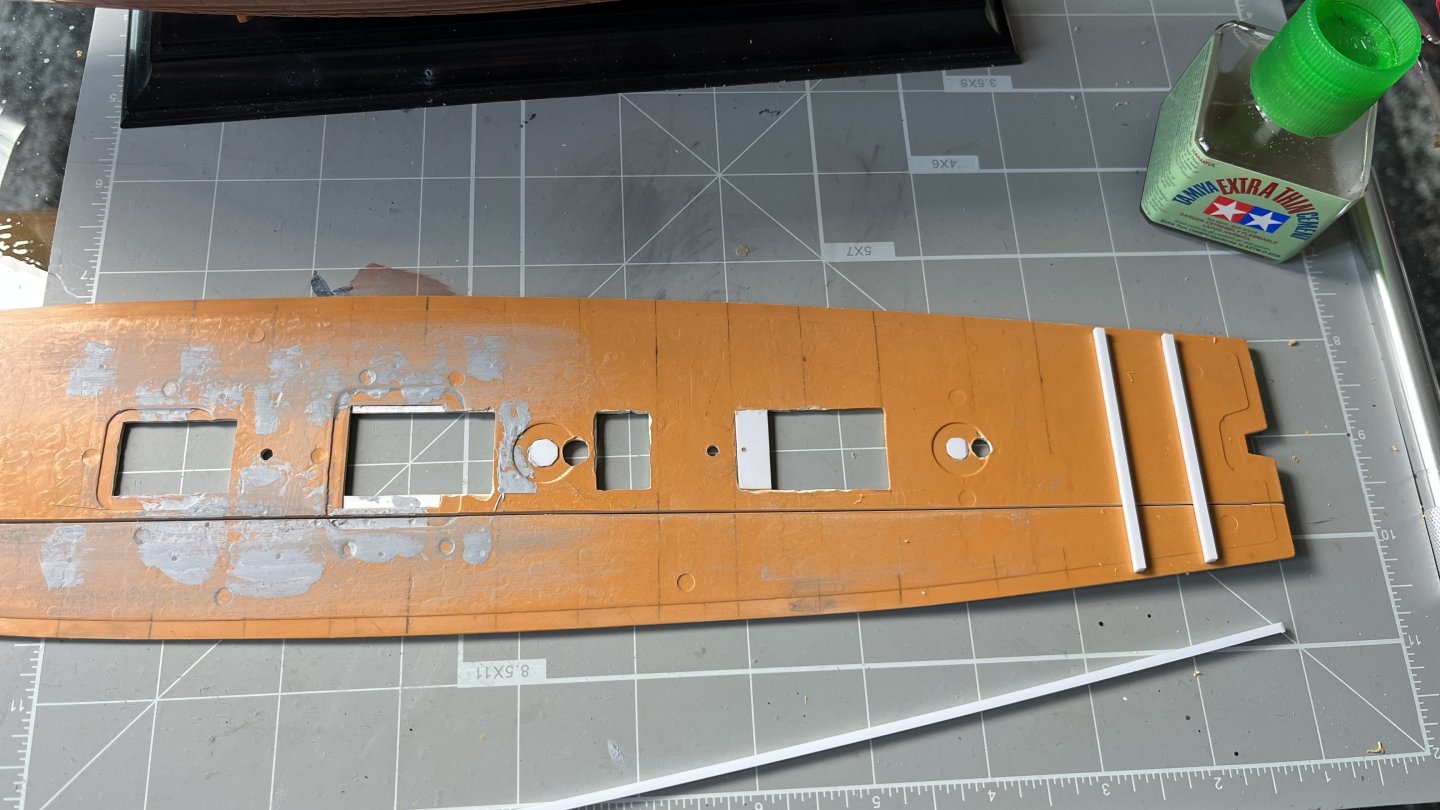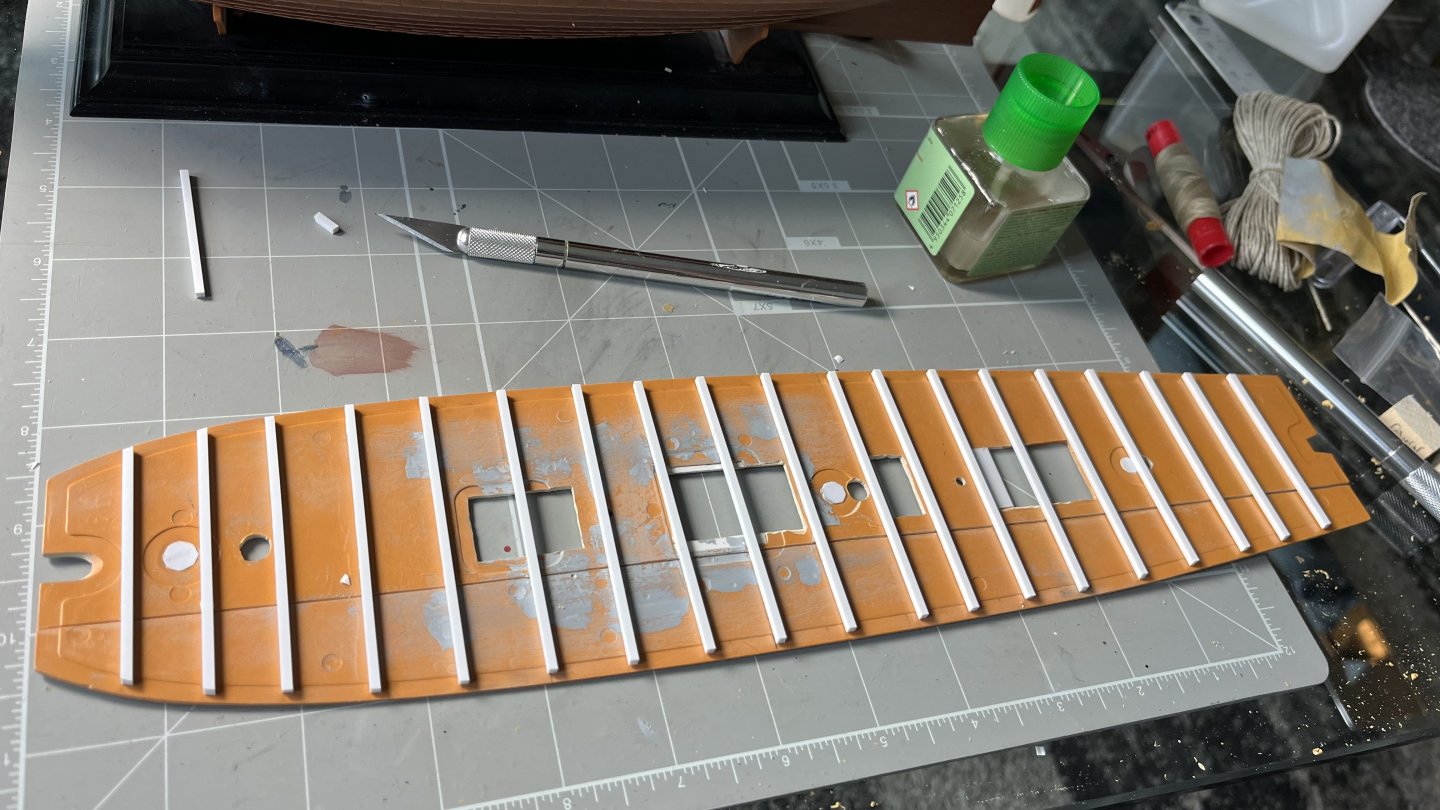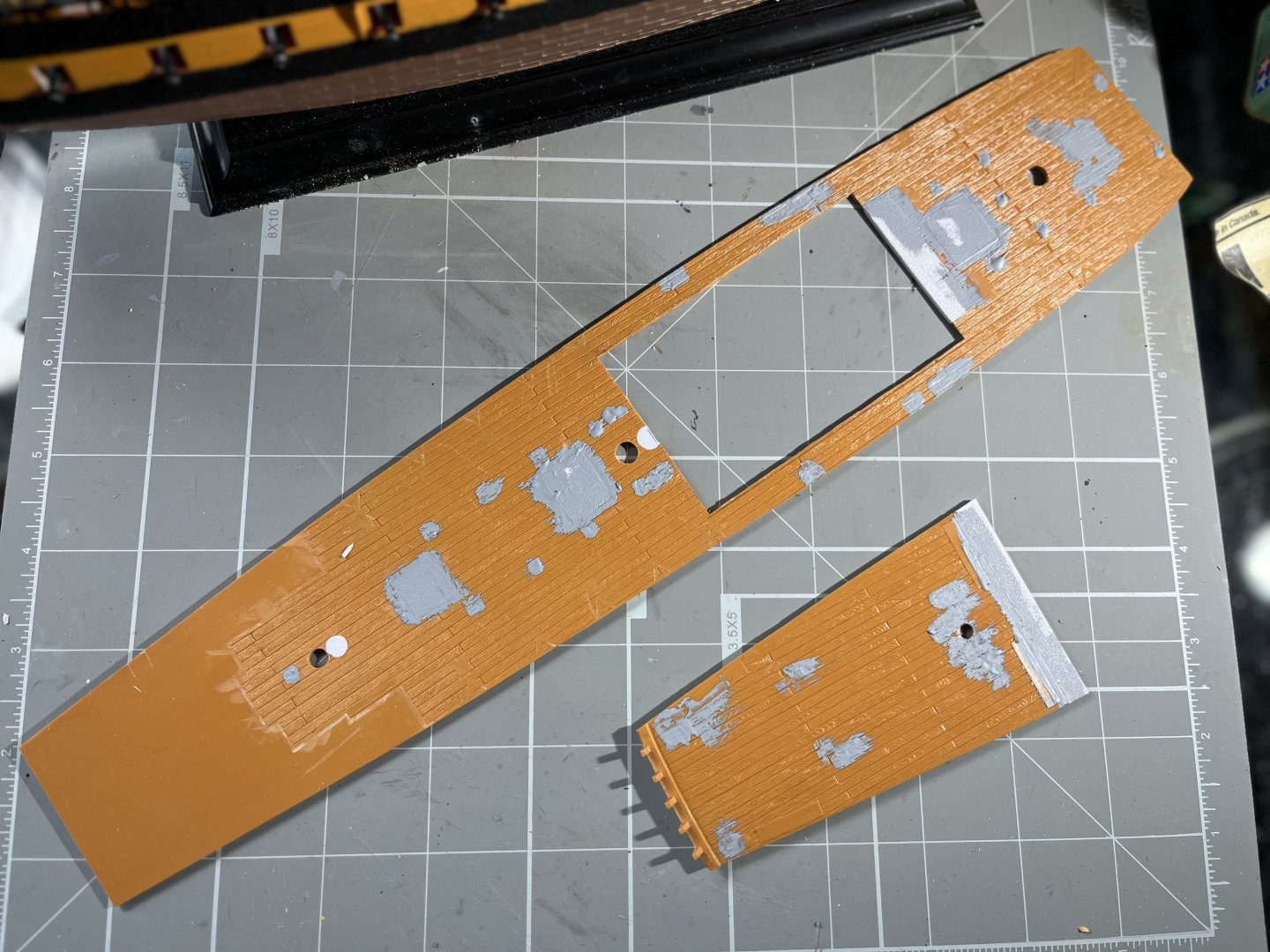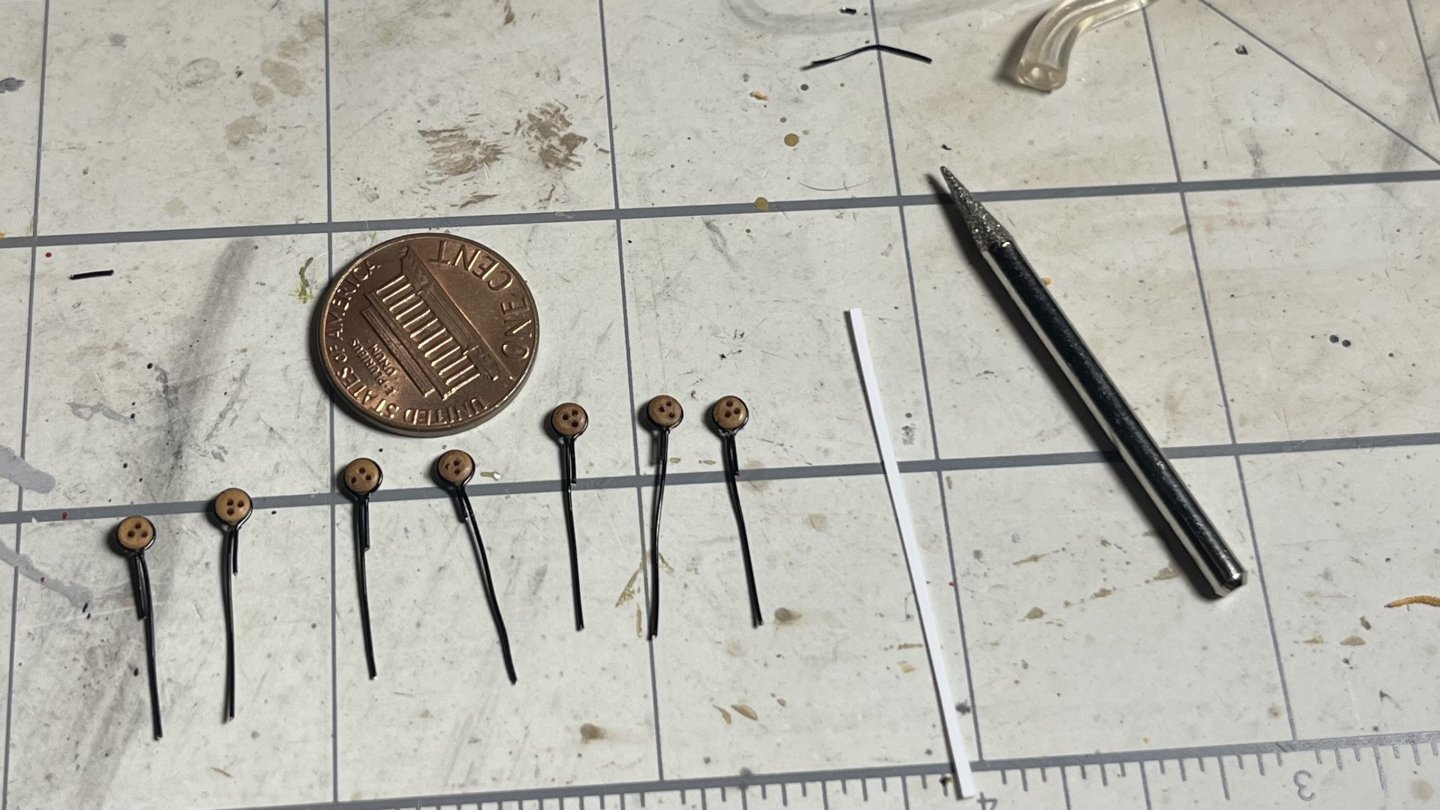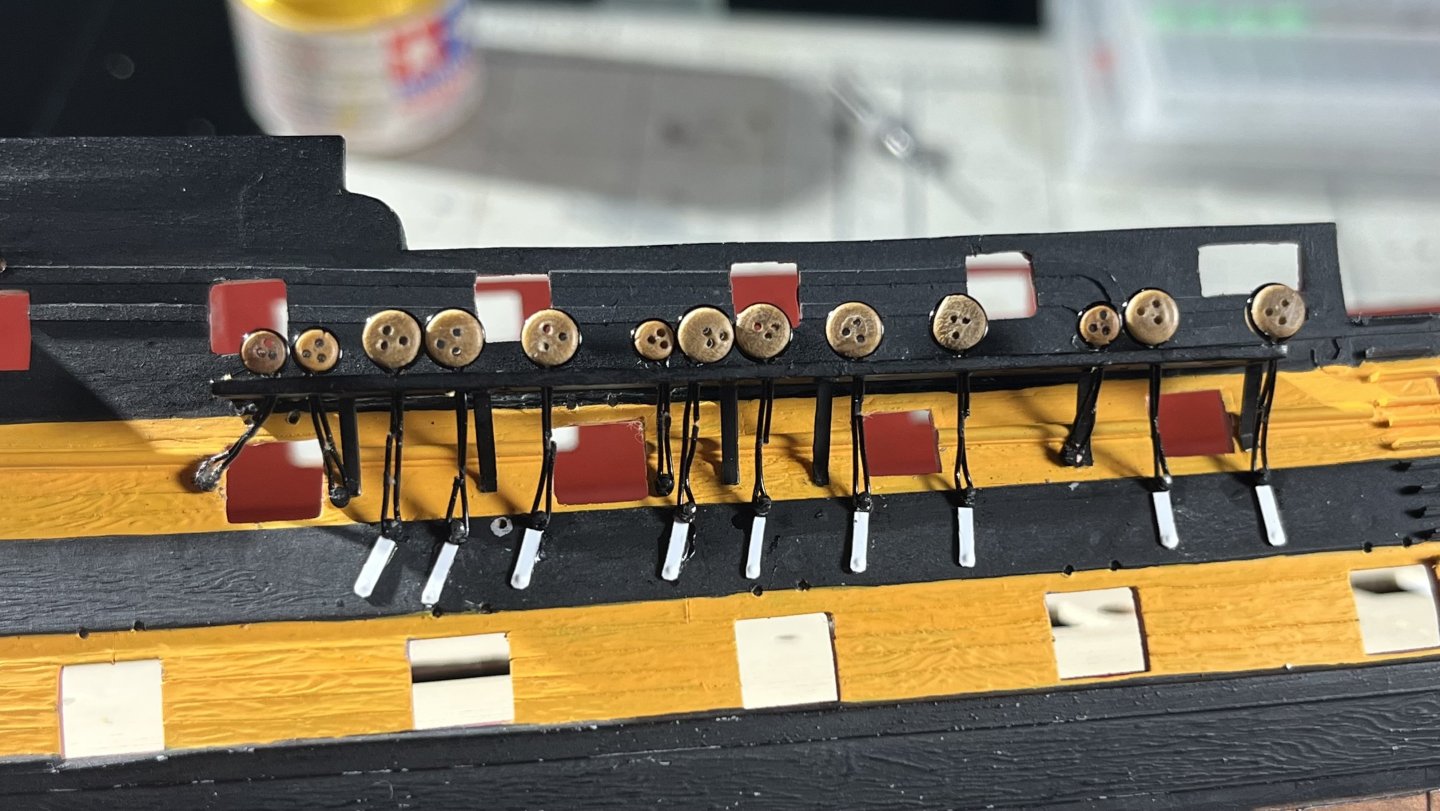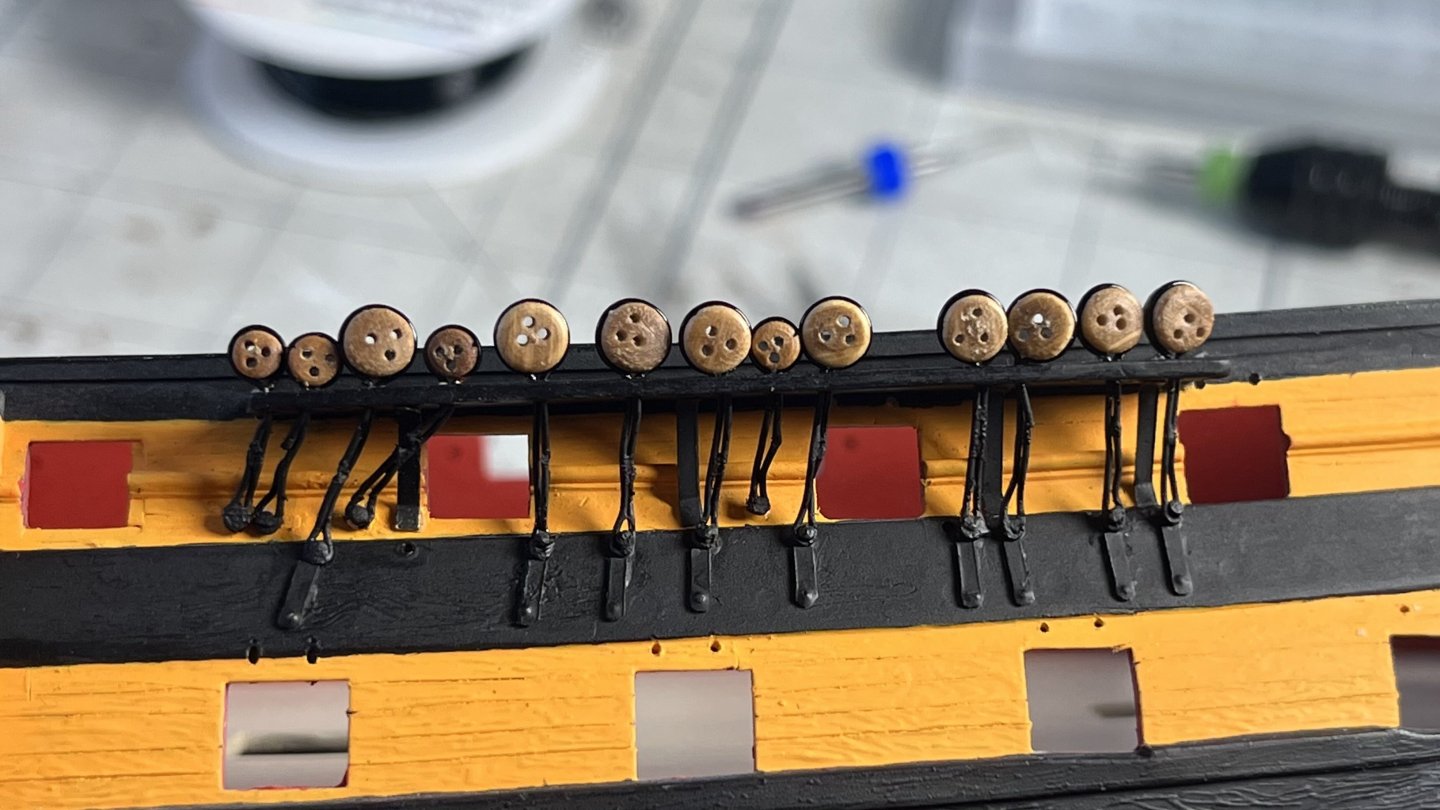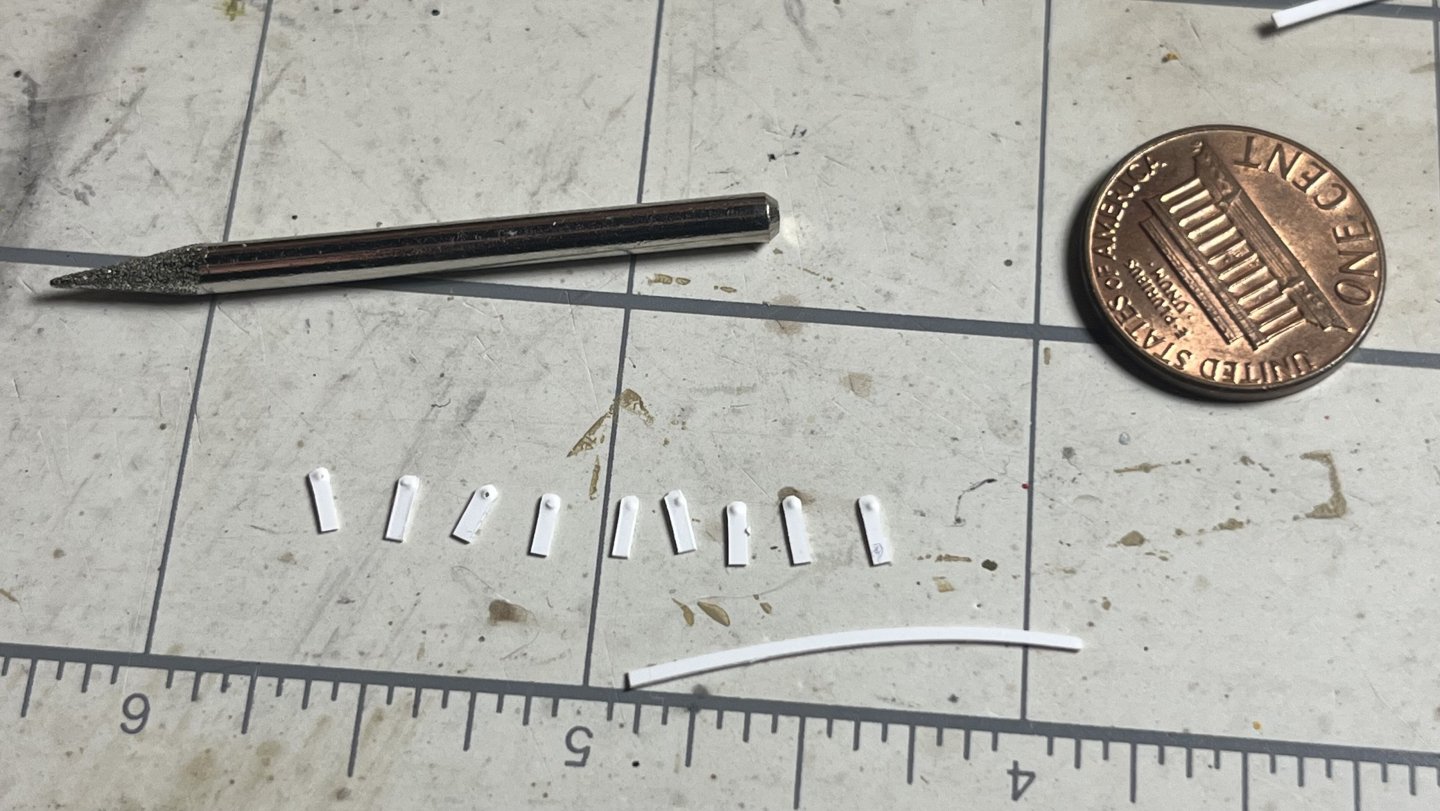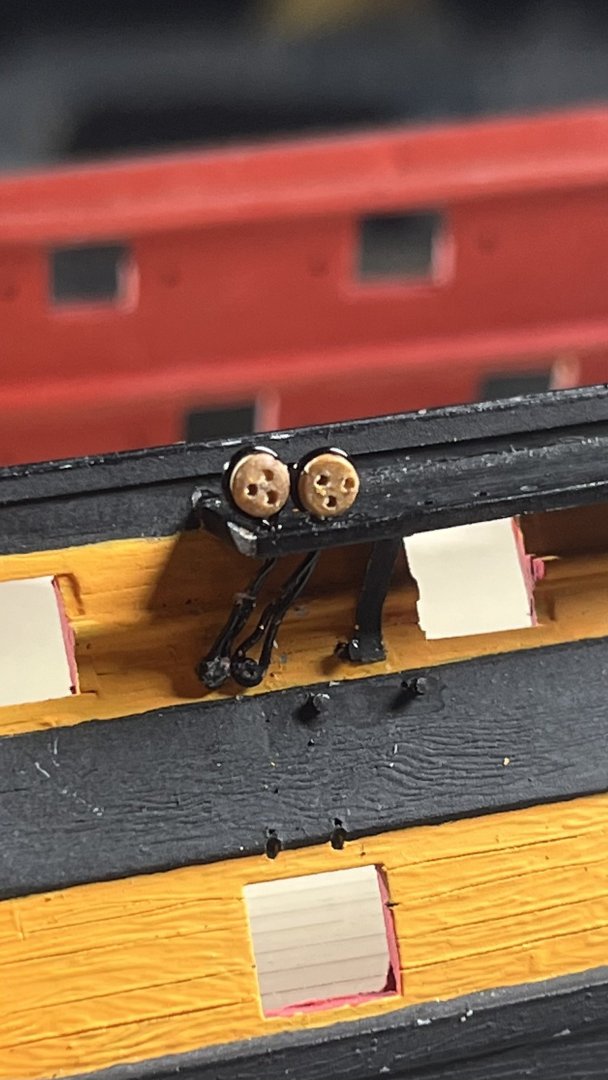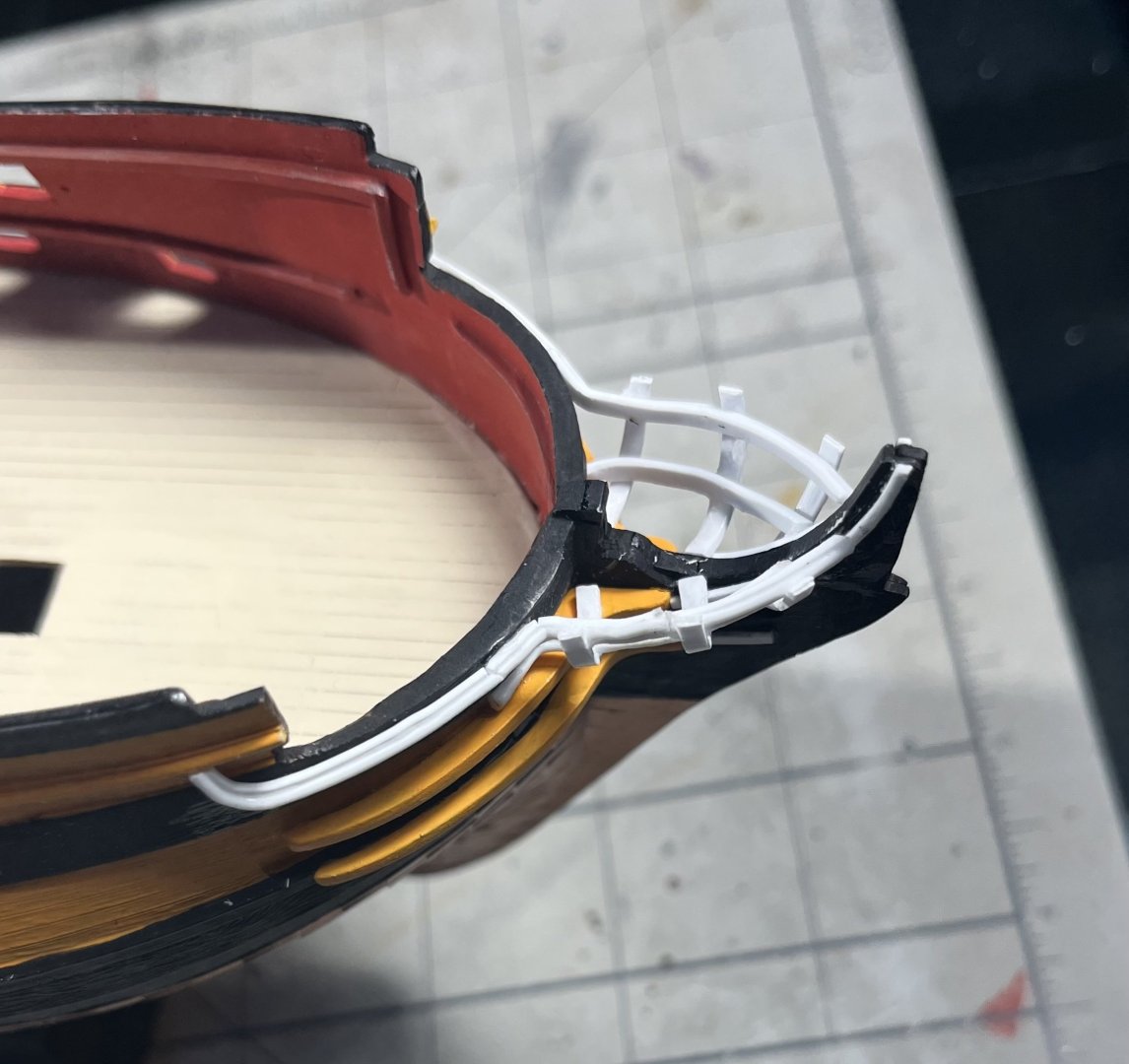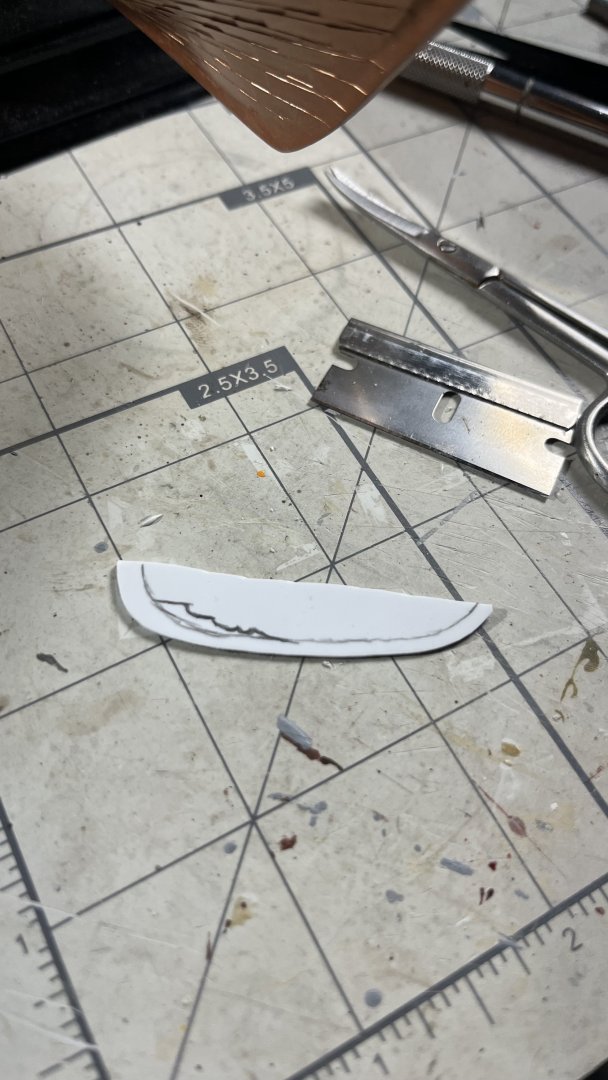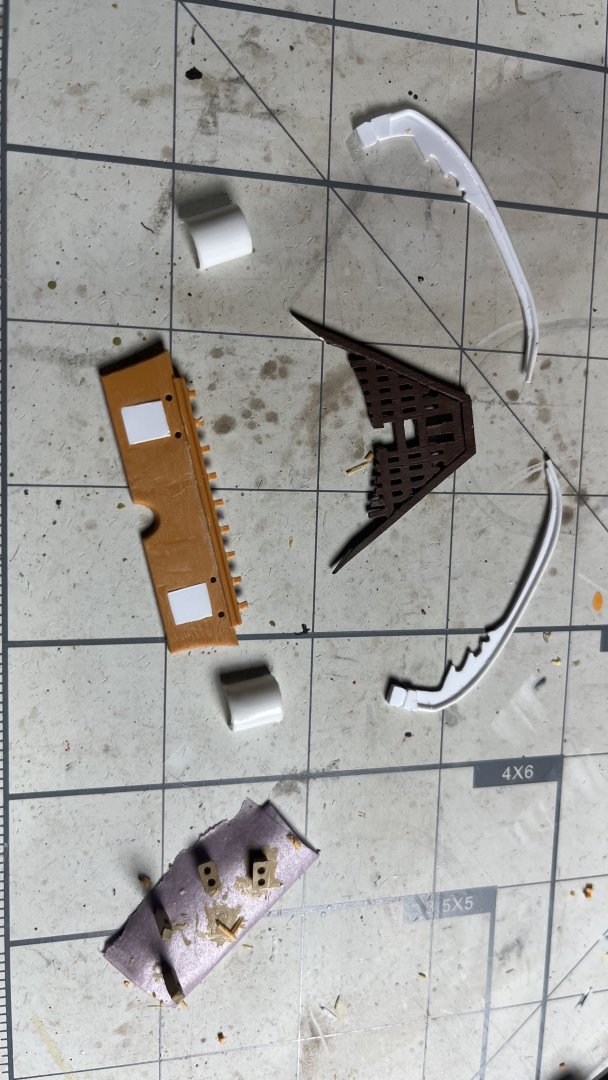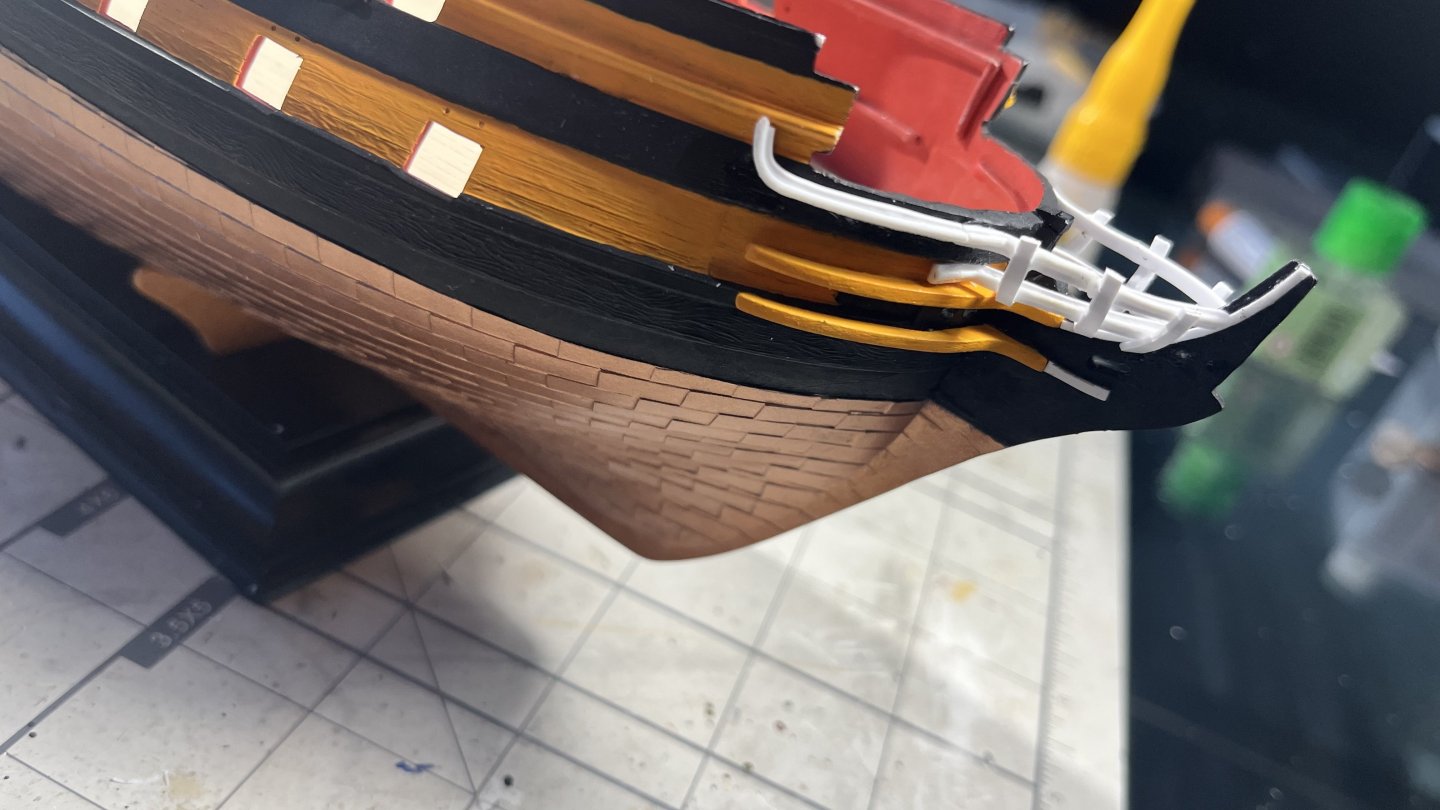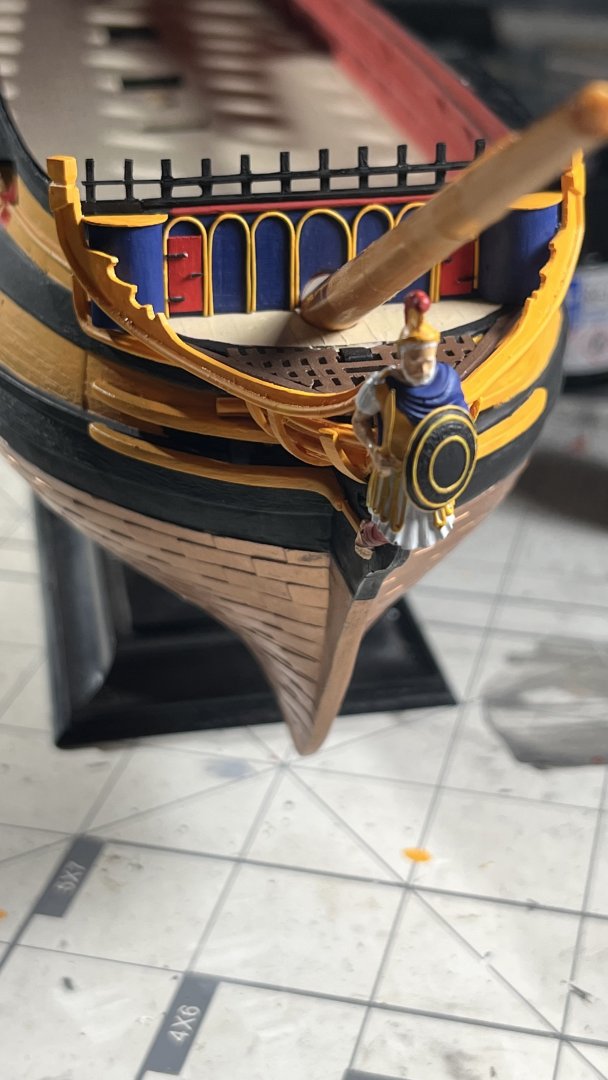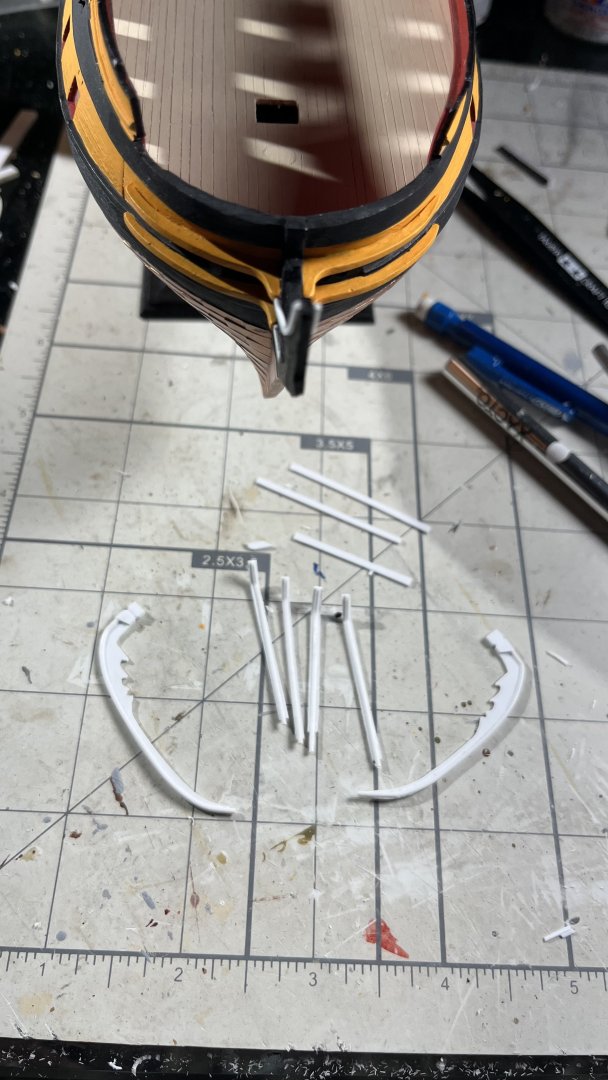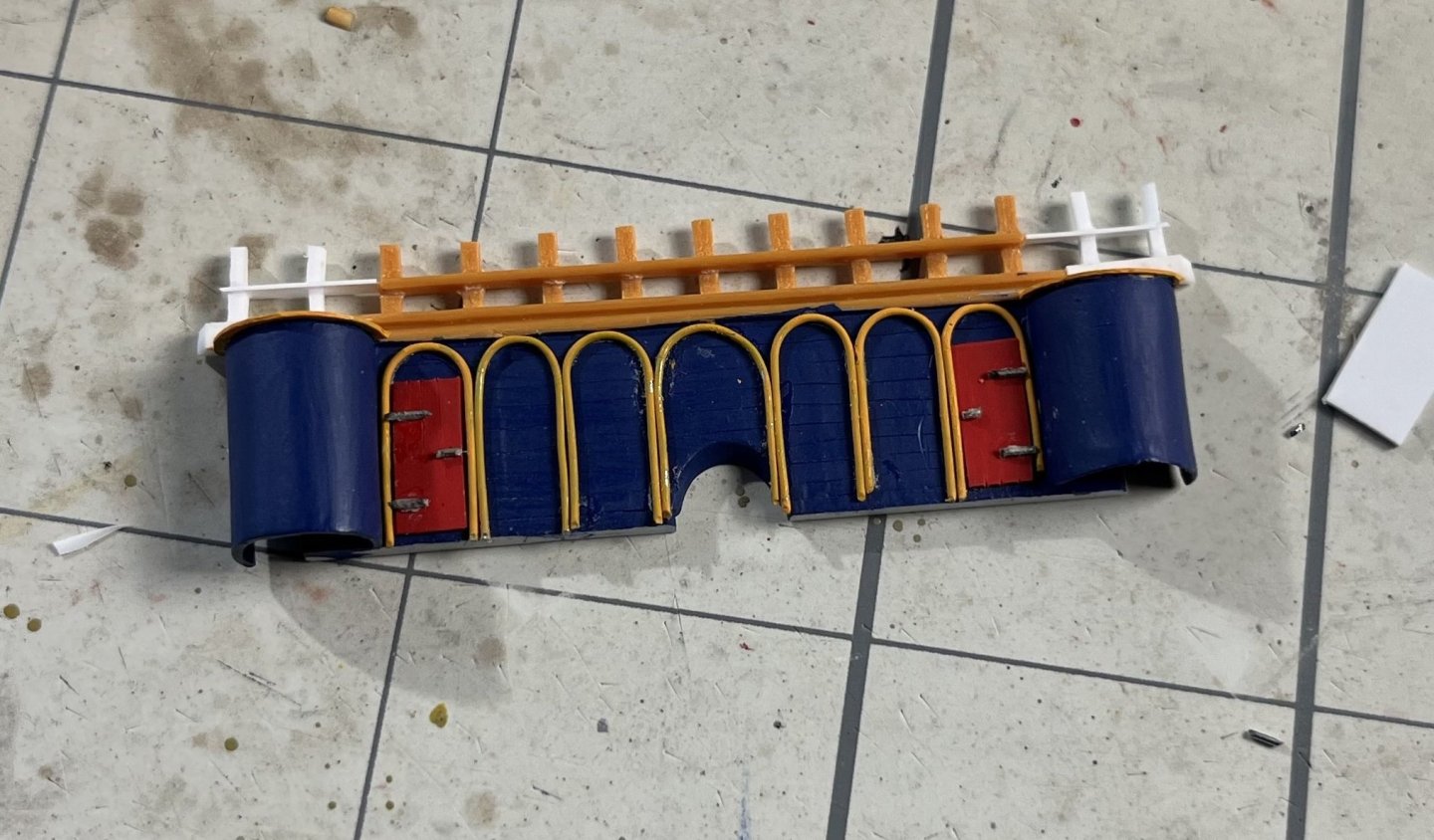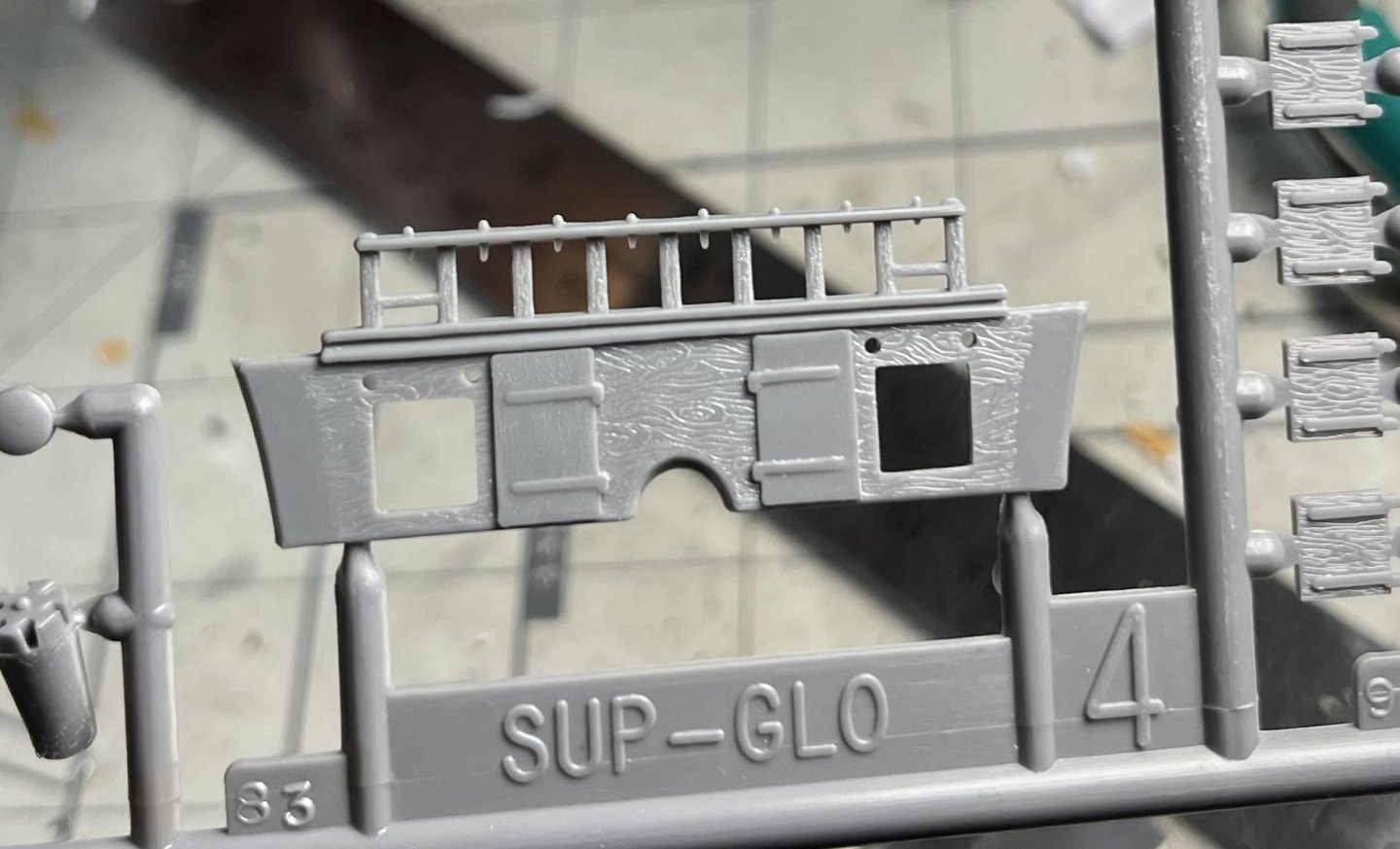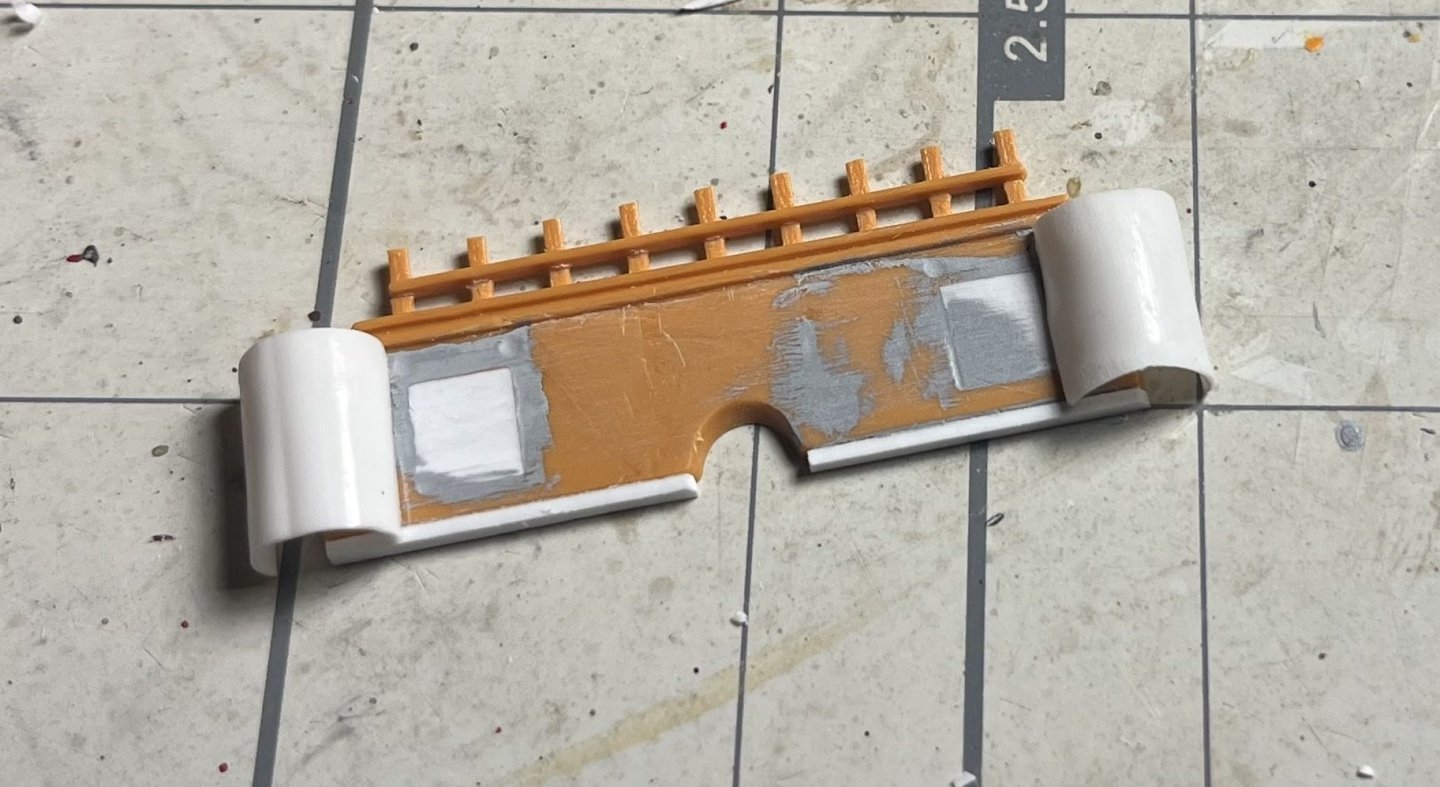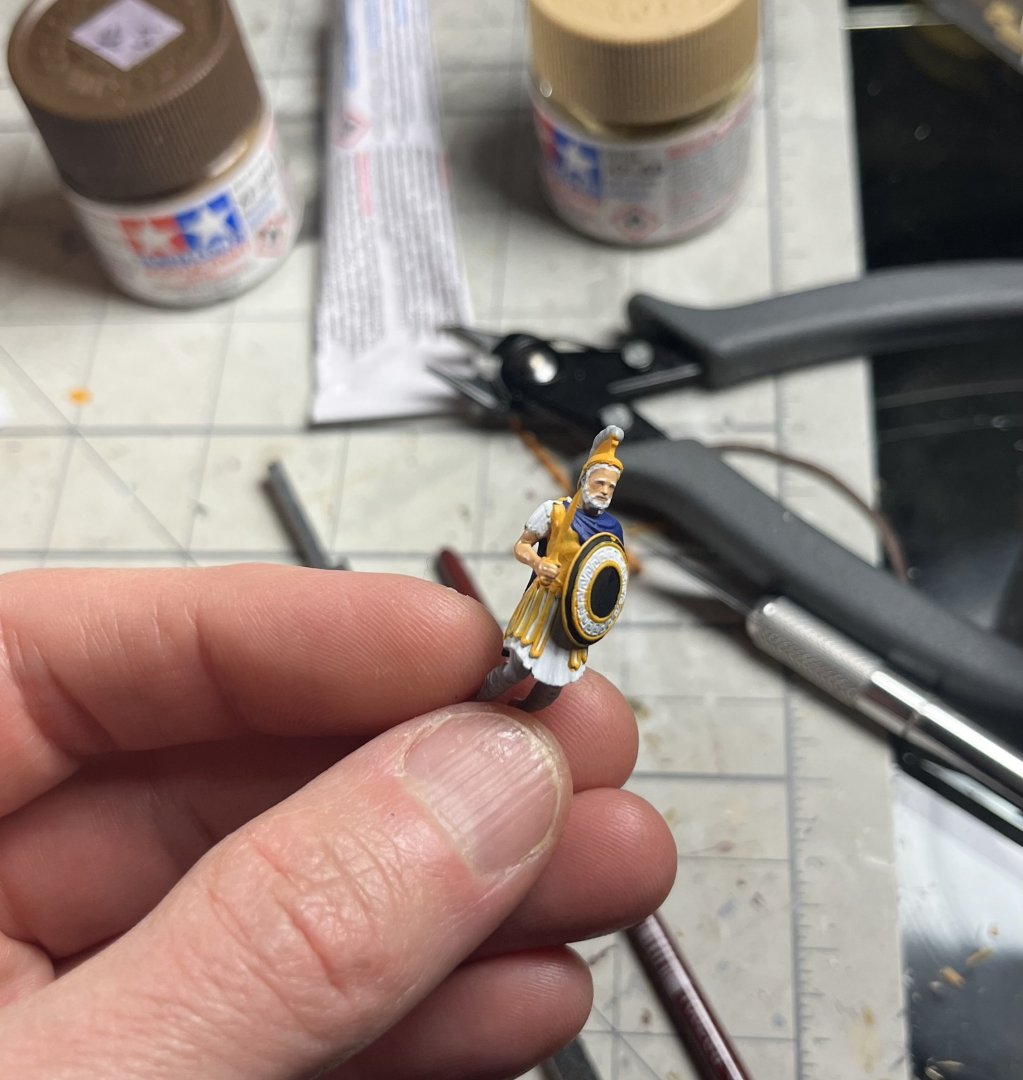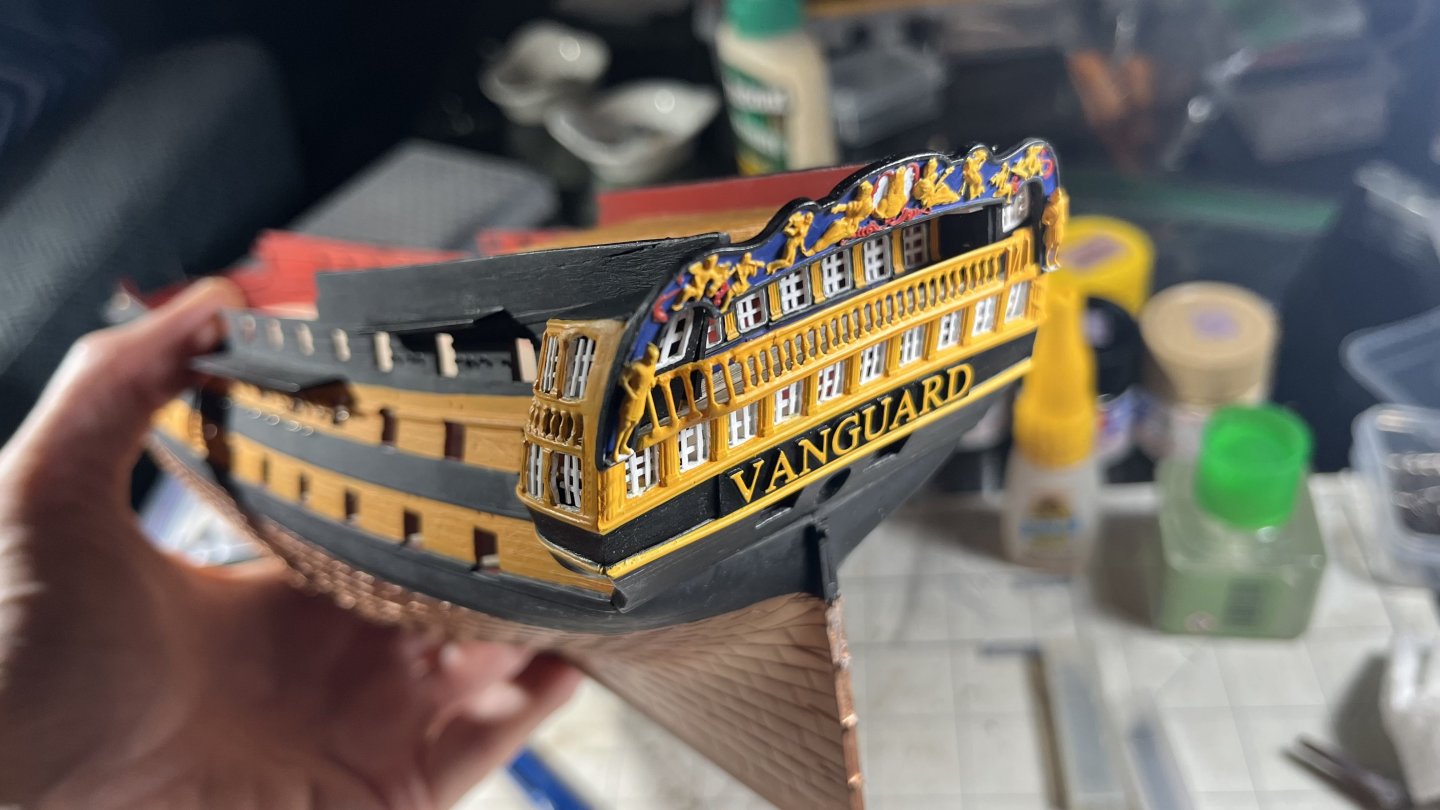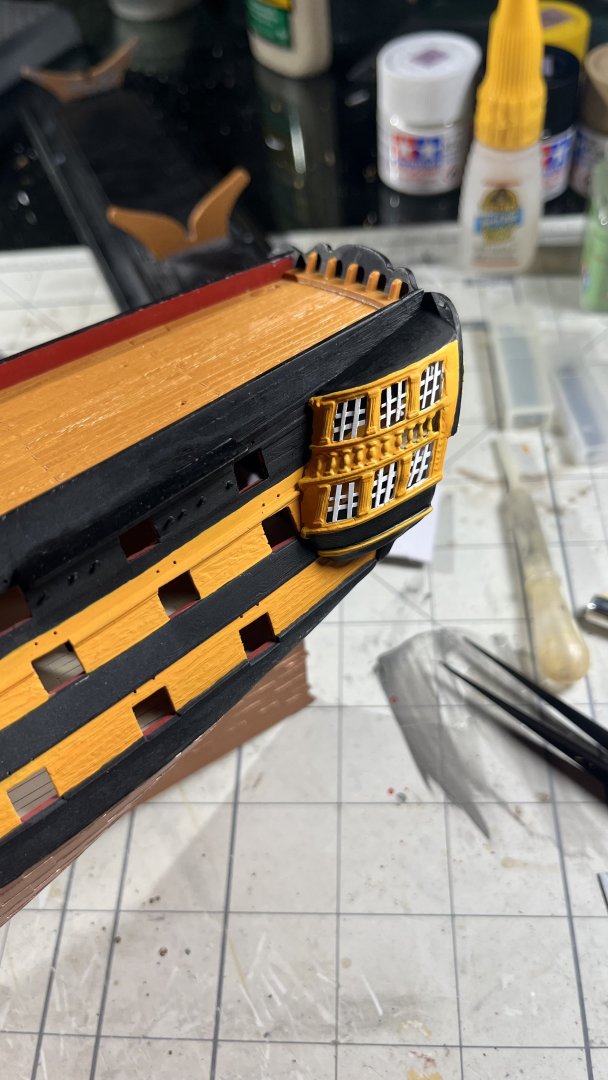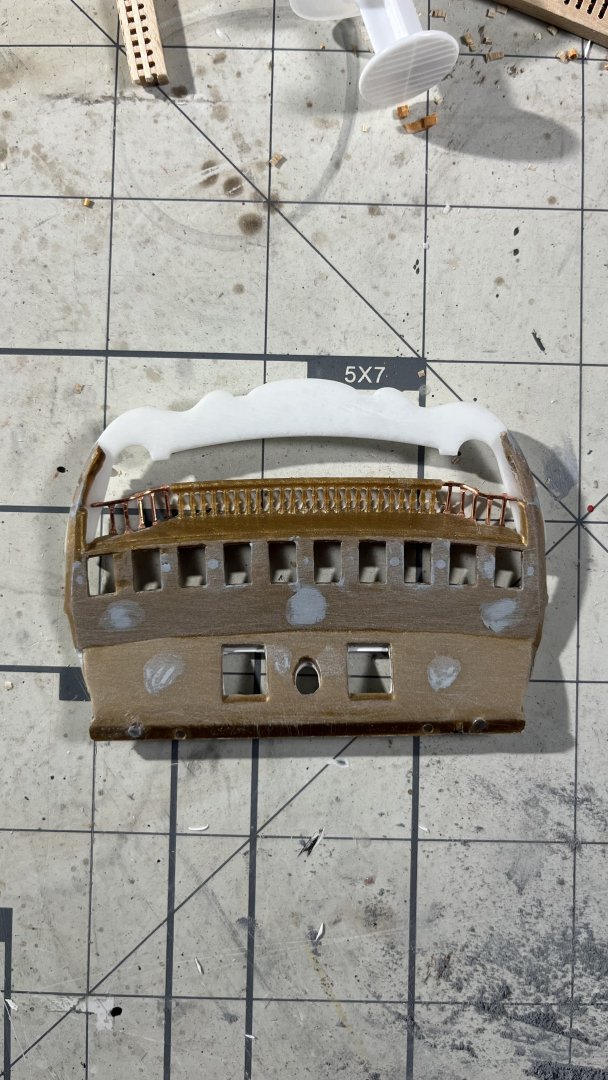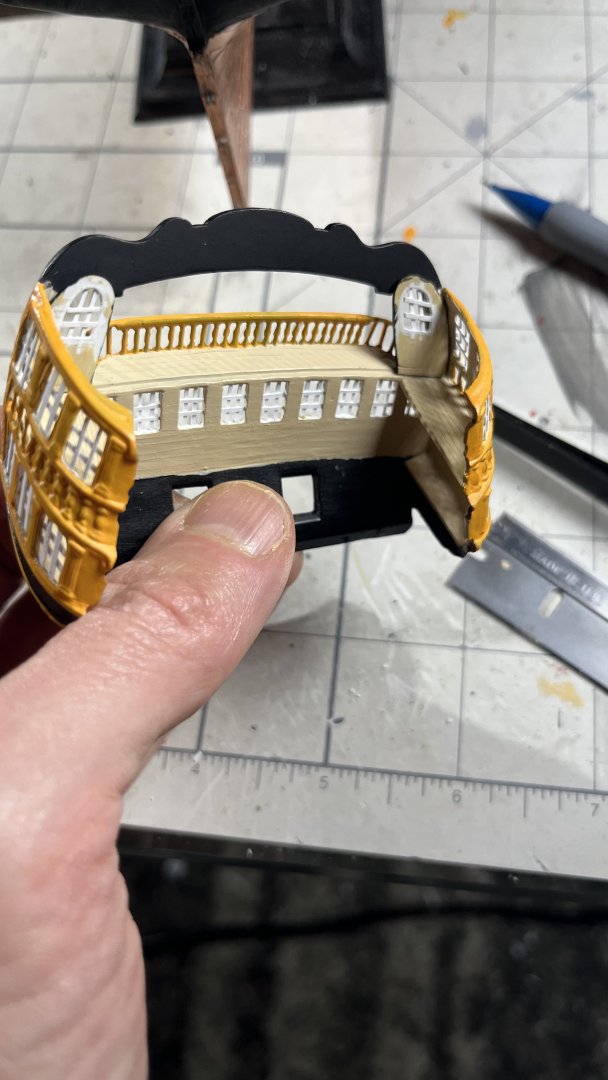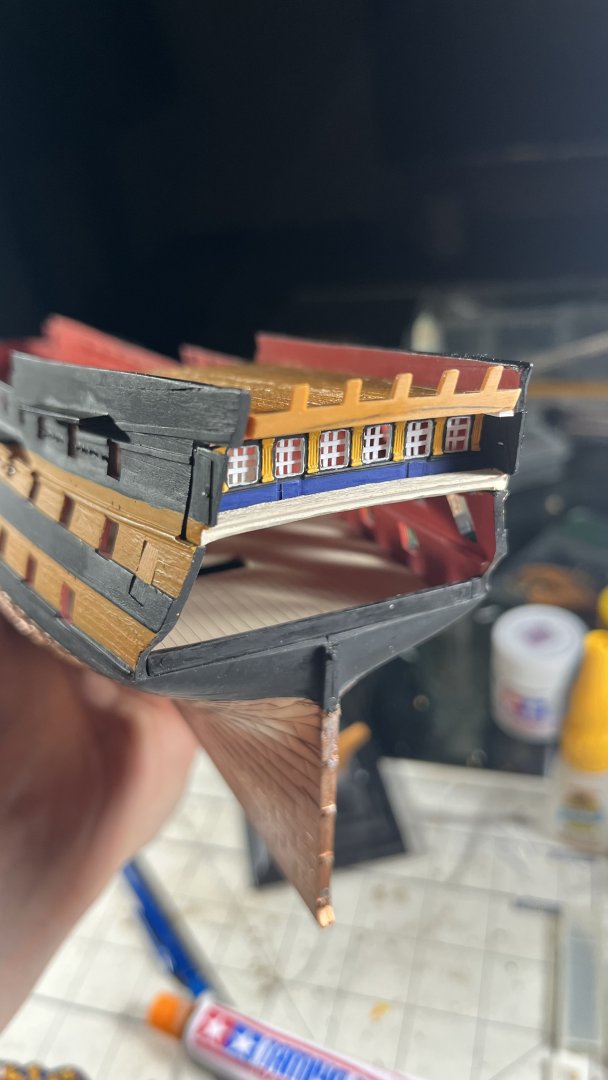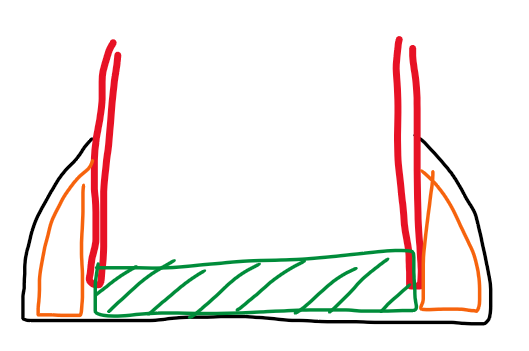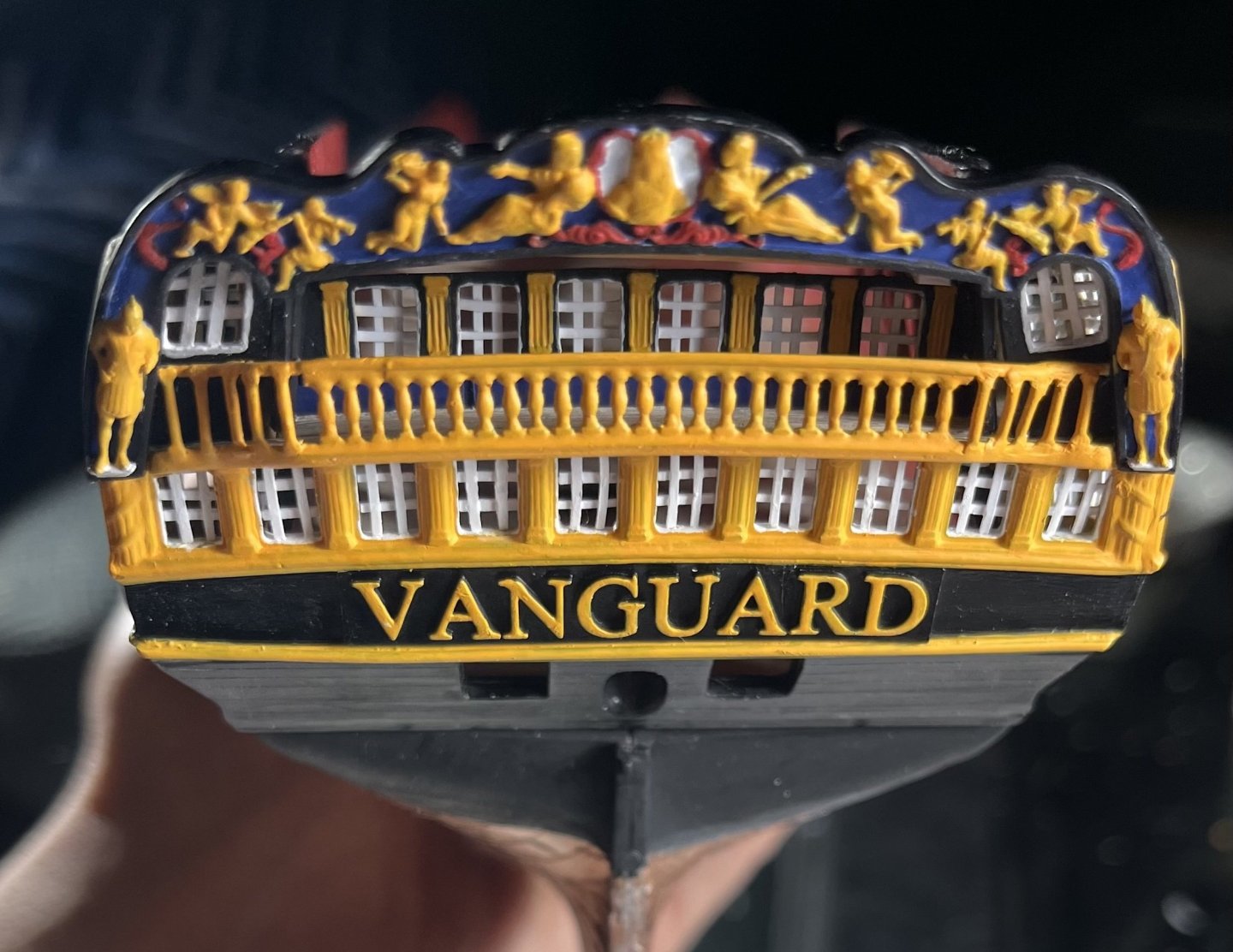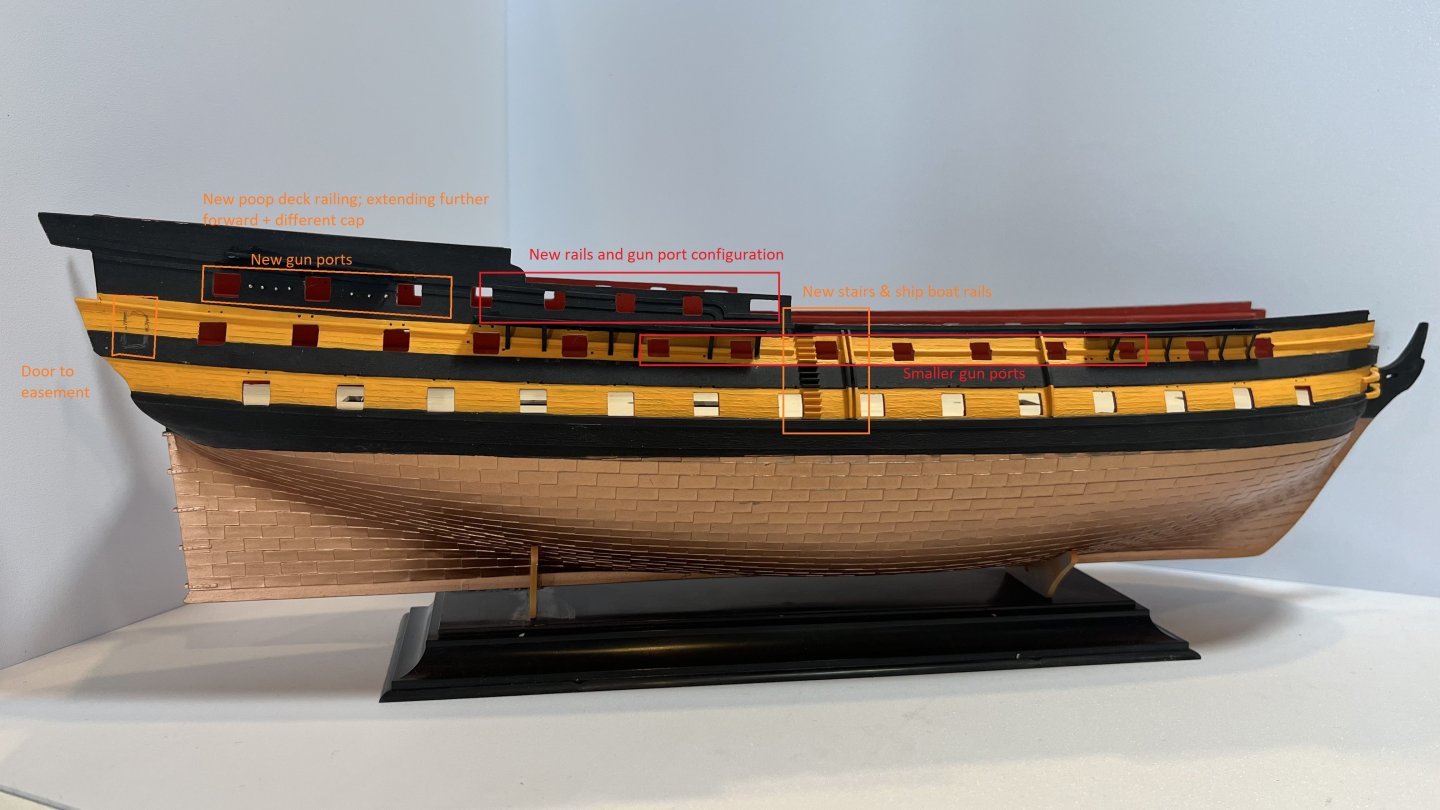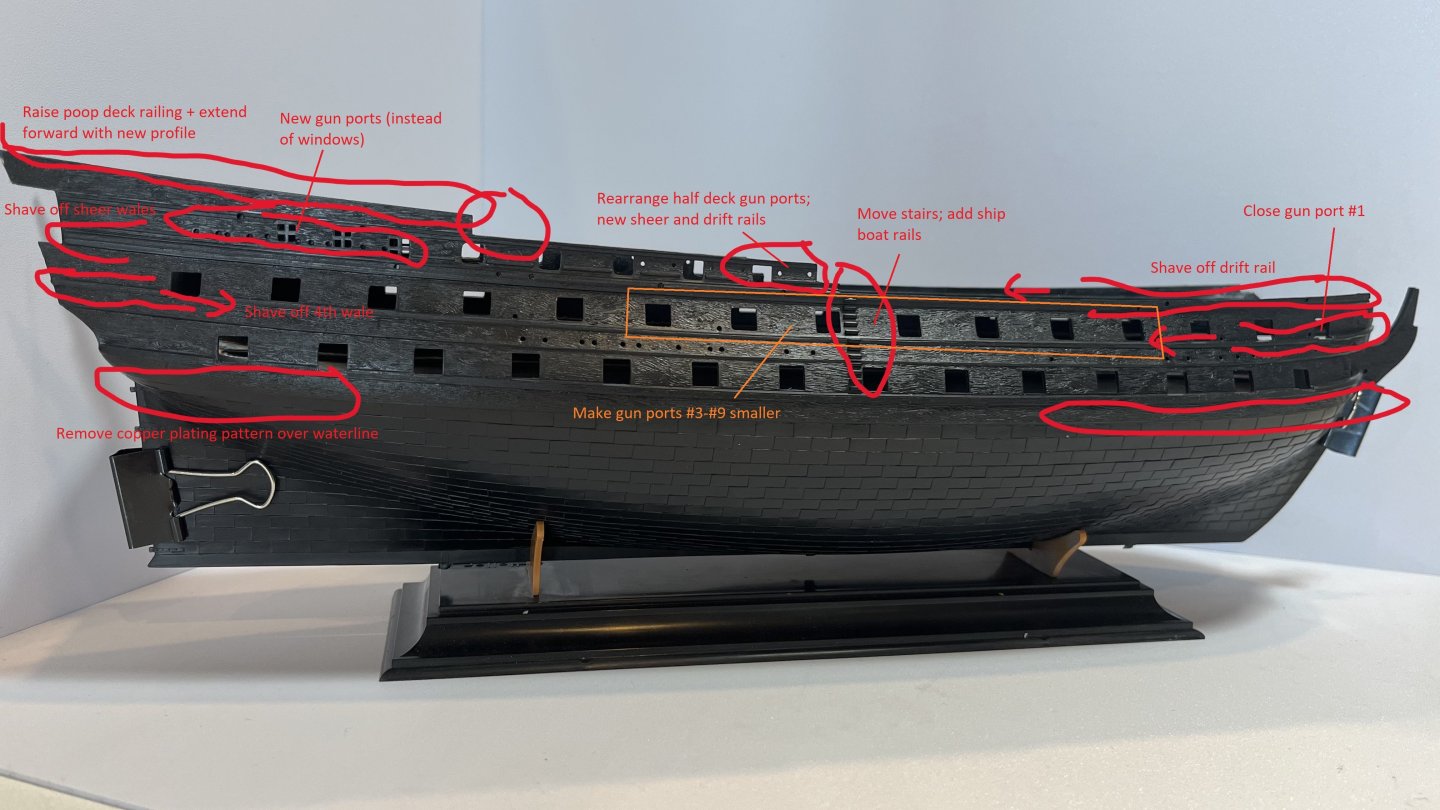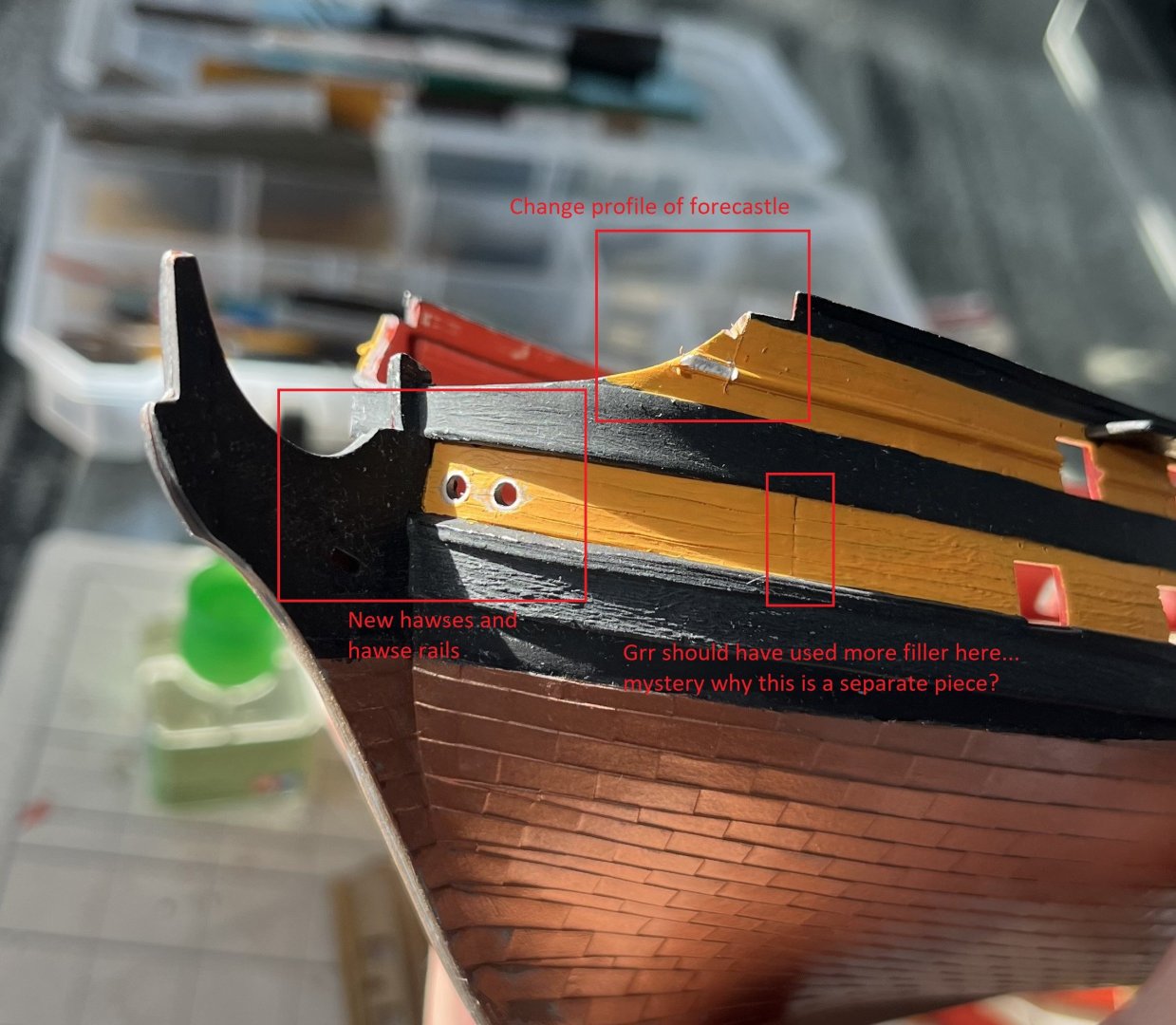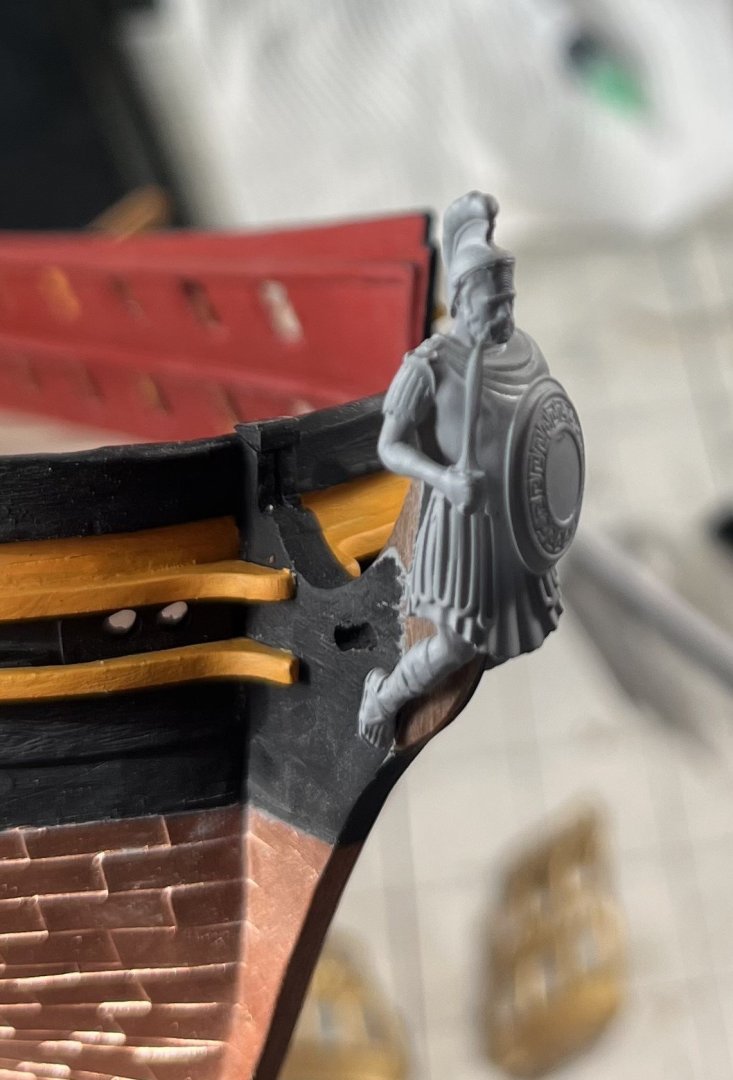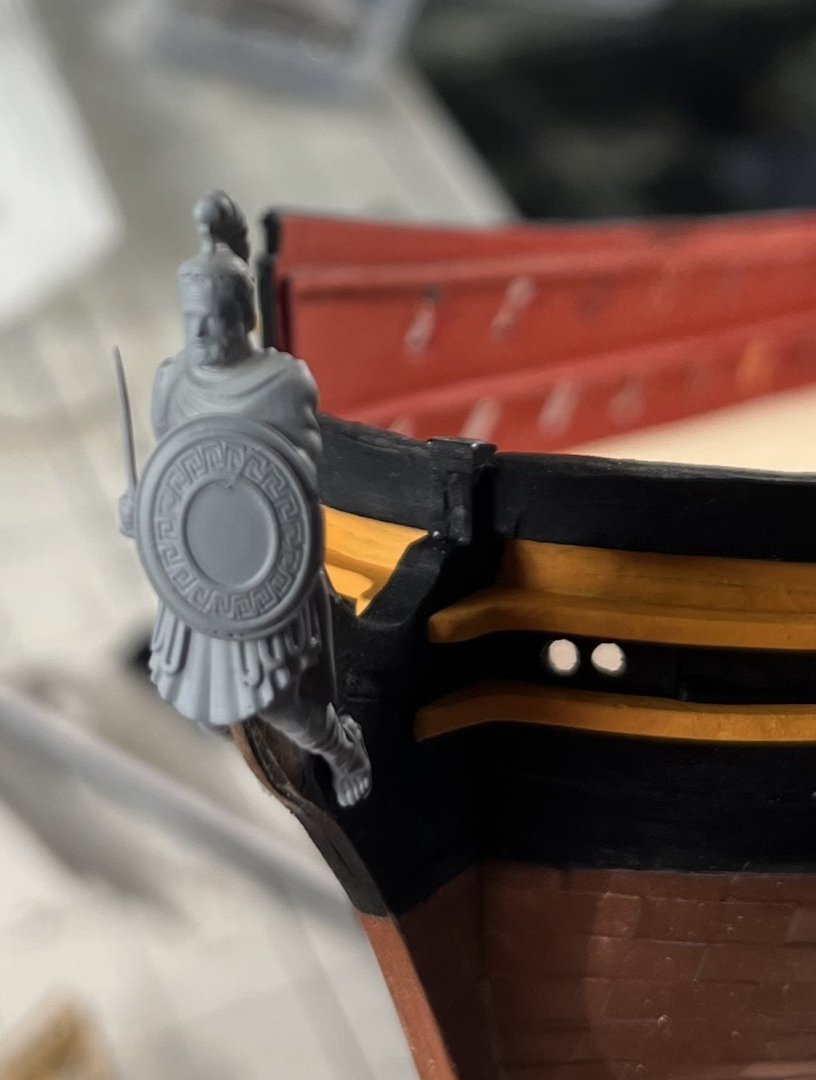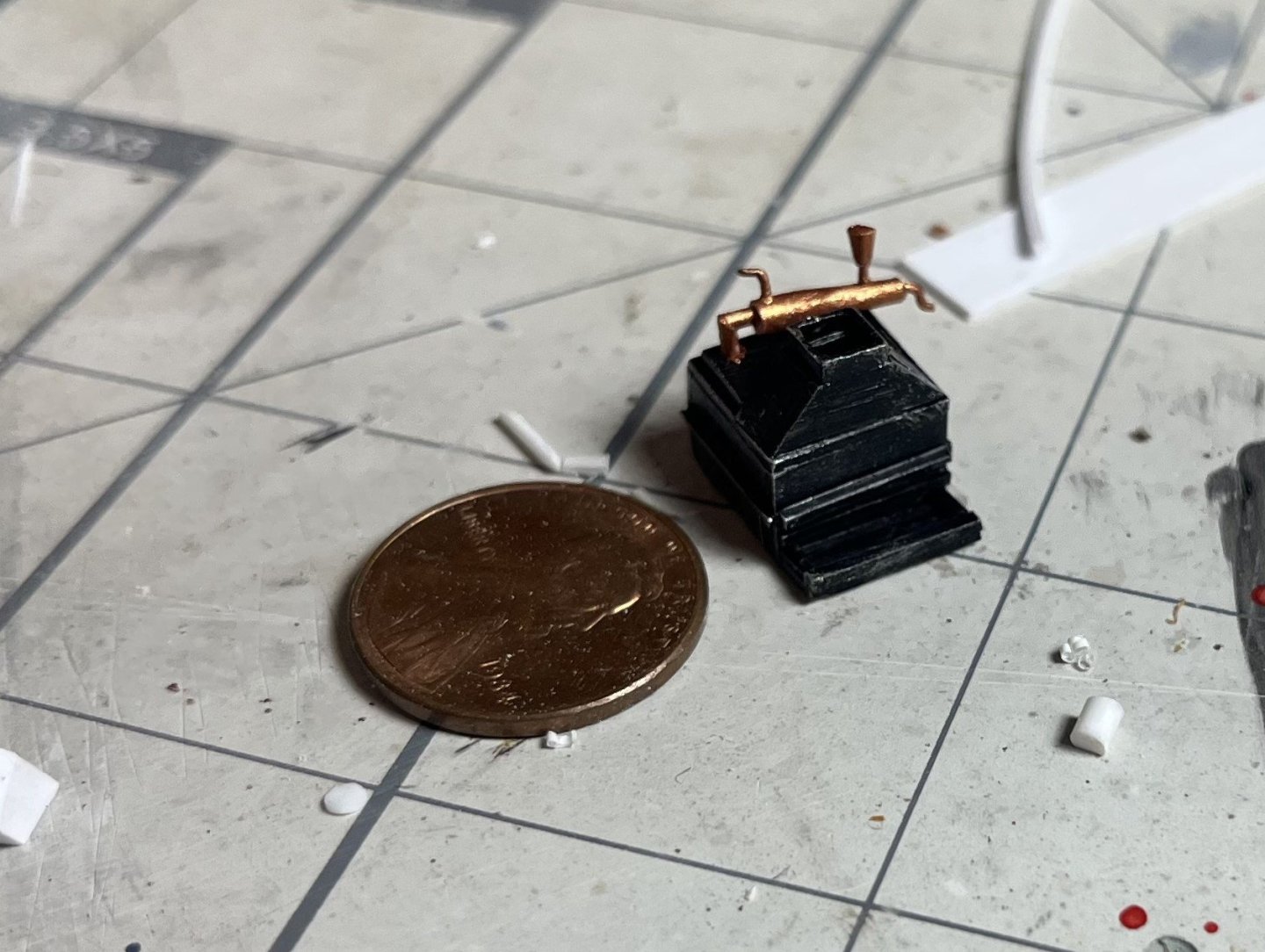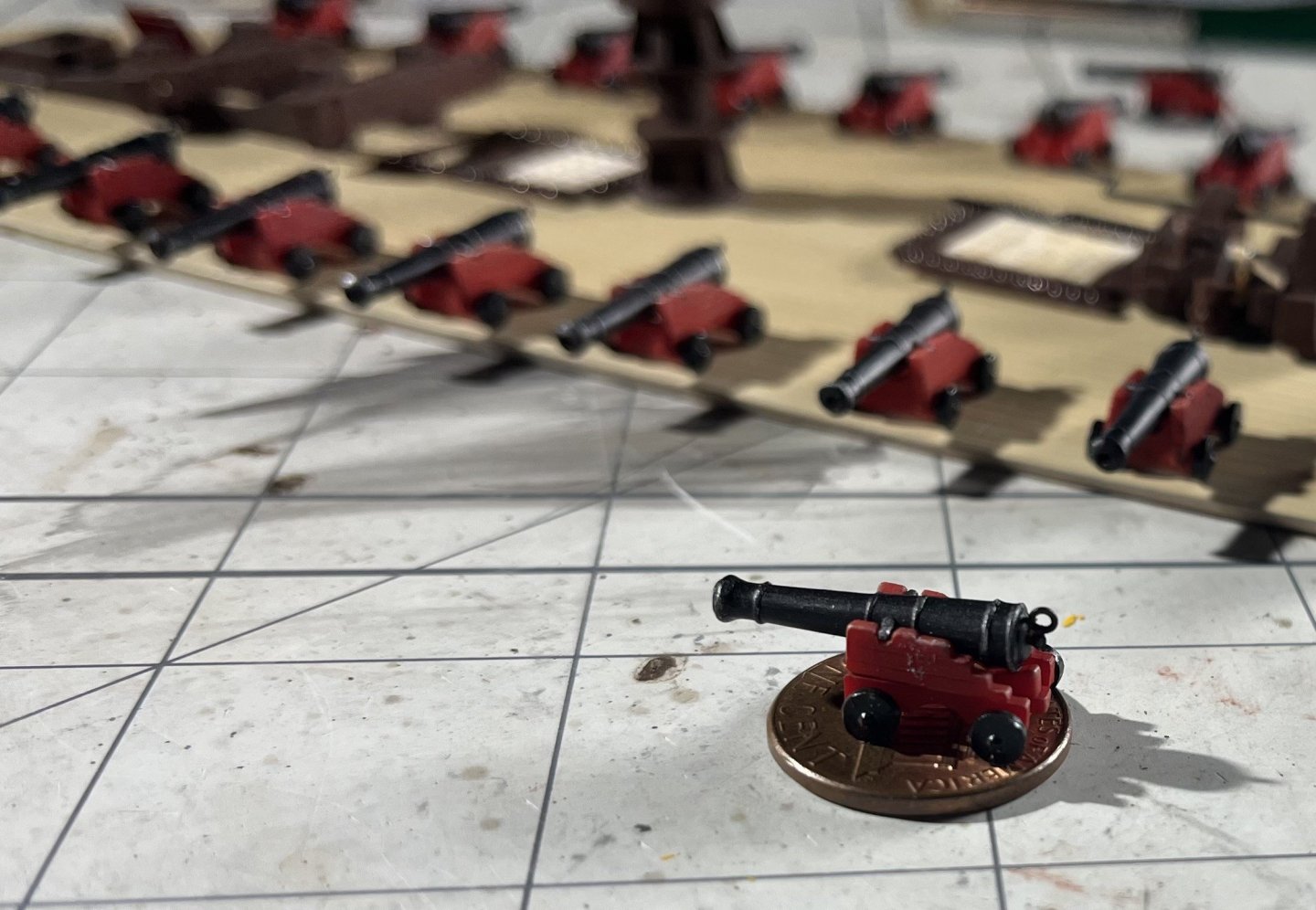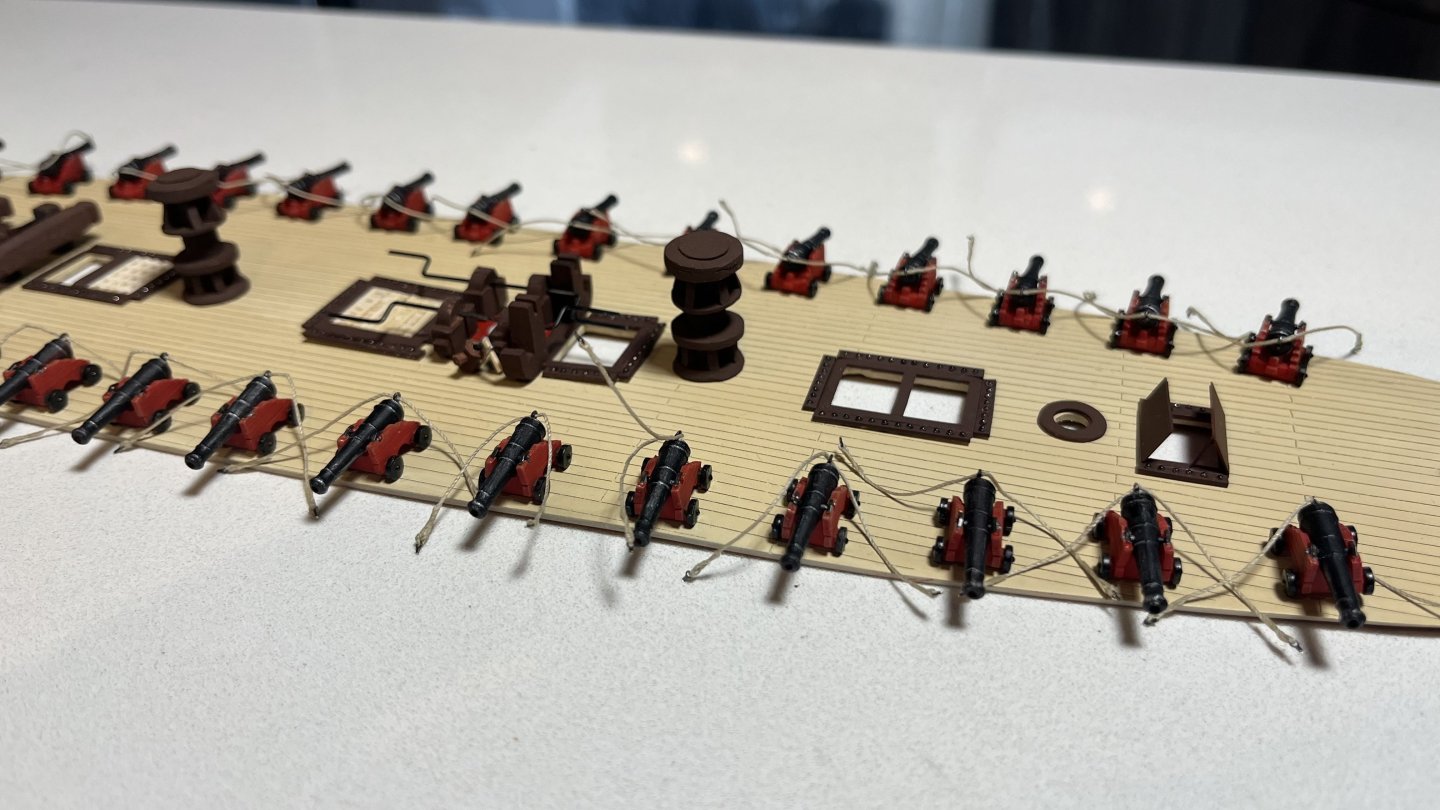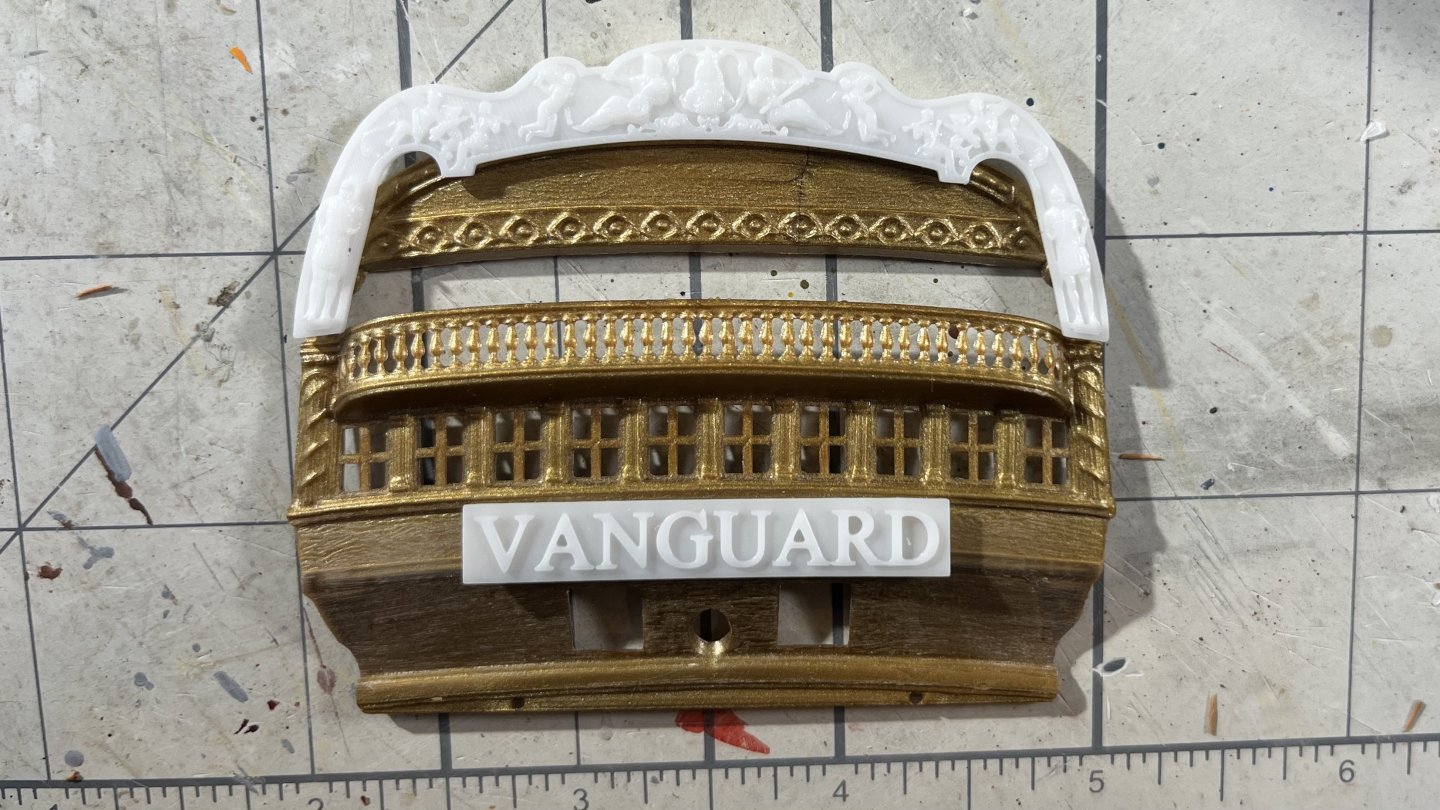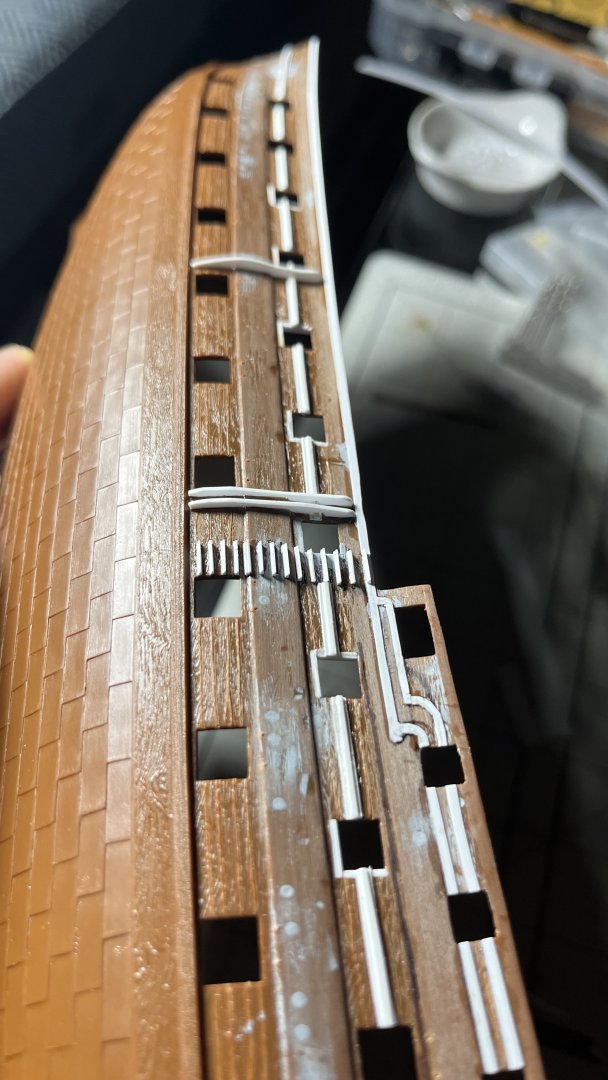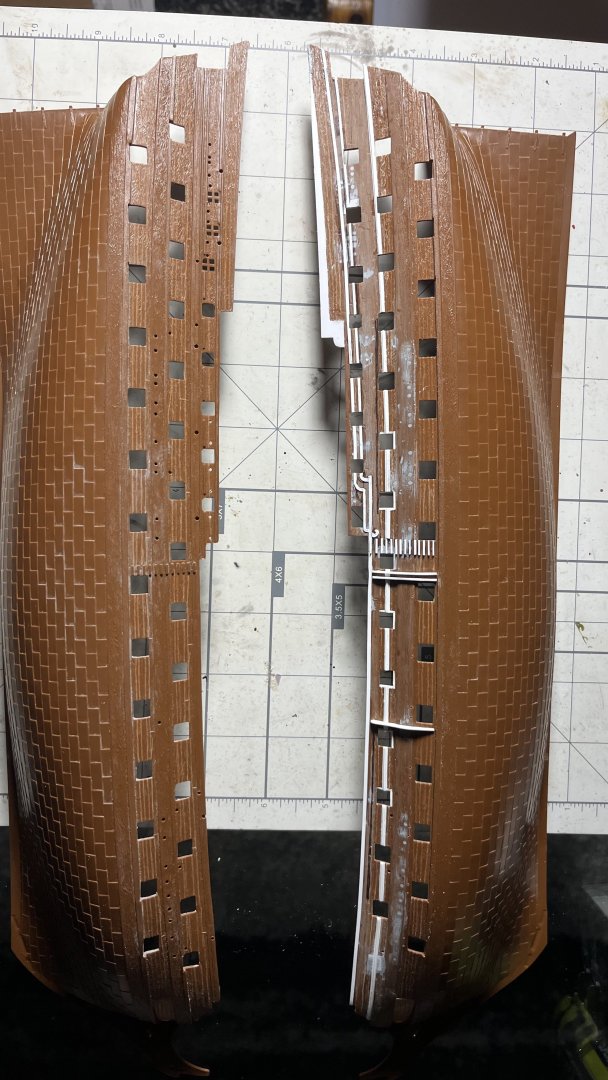-
Posts
51 -
Joined
-
Last visited
Content Type
Profiles
Forums
Gallery
Events
Everything posted by PqLear
-
HMS Victory colors
PqLear replied to Ironhead's topic in Painting, finishing and weathering products and techniques
I also found the discussion incredibly interesting, impressive and insightful. For my own build (Vanguard at the Nile) I also went with a shade some might call ochre, or simply orange-yellow. I also realized from the thread there is no "one single authoritative truth", that coloring schemes and exact shades changed due to weathering, aging, era, and individual preference, and that ultimately I'd be the happiest with my build if I simply picked the color I liked the best -- so that's what I did In Tamiya terms, I used a 10:1 mix of XF-3 Yellow and XF-7 Red -- a shade I was familiar with from other models I'd built and quite happy with. -
With deadeyes completed, have turned my attention to the inside of the hull again, and started assembling the gun deck. A light sanding of the guns will make it easier to glue them in place, although unfortunately it also meant some of them will now sit a little too low in the gun ports. Will go even lighter on the other side. (The small hole in the bottom of the gun carriage is left over from airbrushing/painting.) A tiny dot of CA will hold the breeching line nicely held together just under the cascabel. Note eye bolts at end of breeching ropes -- they're from Amati, I cut off ~4mm and used the excess to make cap squares. Gun deck half-way assembled. Starboard battery, anchor cables, and pull strings for gun lids remain before upper deck can go on. As mentioned above, I cut the upper deck in two pieces to be able to put it in place without breaking up the hull. Even this approach is proving quite complicated -- wish me luck, I'll need it! I started this part of the project by adding beams under the upper deck: All in place, glued onto the larger part only... ... so that I can add the upper deck as a two-step process; first, the larger piece, then the starboard battery -- quite tricky to maneuver the guns and breeching lines in place between the beams, but hopefully it'll be okay -- and finally the smaller deck piece. Unfortunately, this means I won't be able to take a picture of the entire gun deck fully assembled 😕 Started prepping the forecastle/quarter deck. First, original piece (note new holes for masts, as described ^^) Started by cutting/shaving everything down -- gratings, stairs, gun racks, placeholders for buckets, etc. -- to get a flat deck. Filled resulting holes with squares of 2mm plasticard. New location and different dimensions for the midships opening. Narrower gangways. Cut new opening and closed up resulting gap in forecastle. Plenty of filler to close holes and cracks. Note extended front of poop deck also. As always, thanks to @glbarlow and @dafi -- I've used your build logs liberally as inspiration and reference (e.g. here, and here). Not all my gratings, stairs, capstans etc. are in the correct places since the hull dimensions are different, but I'm quite happy with the result (which no one will ever see anyway ) I should probably have thought about this sooner... but finally got around to buying the instruction book for Amati/Victory's Vanguard -- realized it'll be invaluable for the rigging, but it would probably have come in handy for the hull, too. Oh well.
- 24 replies
-
- HMS Vanguard
- Heller
-
(and 2 more)
Tagged with:
-
Thank you sir - and thank you for giving me the inspiration to pick up the hobby again! Maybe next time I’ll try it in 1:100….
- 24 replies
-
- HMS Vanguard
- Heller
-
(and 2 more)
Tagged with:
-
Nice thanks for the recommendation - have ordered it now.
- 24 replies
-
- HMS Vanguard
- Heller
-
(and 2 more)
Tagged with:
-
Browsing through some other Superbe threads, I found this comment that appears to confirm my guess the original kit was launched in 1977: https://modelshipworld.com/topic/34701-le-superbe-by-greenskin-heller-1150-plastic/#findComment-989109 -- thanks @Henke (och hej, kul att se fler svenskar! Henrik här också... ) I also stumbled across a YouTube channel with some pretty neat CGI recreations of historical battles, Epic History - YouTube, including a half hour episode of the Battle of the Nile which appears well researched and filled in a few gaps in my understanding both of the battle itself, and the lead up. I especially appreciated how it gives a sense of the scale and distance to shore.
- 24 replies
-
- HMS Vanguard
- Heller
-
(and 2 more)
Tagged with:
-
This is a beautiful build @greenskin, I'm really impressed by how the standing rigging comes along, and your weathering. It's a challenging kit for sure. Look forward to how it all comes out! "I couldn't level the deadeyes, the plastic masts are too bendy" -- do you mean you weren't able to get the upper deadeyes all perfectly lined up horizontally? Any advice?
- 27 replies
-
- Le Superbe
- Heller
-
(and 1 more)
Tagged with:
-
Okay, raise your hand if you've ever mounted the channels and drilled holes in them for the shrouds to line up nicely with the upper deck gun ports, to carefully avoid a 24-gunner blasting away the chains with the first broadside of the battle. Great I see a lot of hands! Now, keep your hand up if you realized a bit too late they ALSO need to take the 12-pounders on the fo'c'sle and quarterdeck into account... ping me your nick and I'll send a membership card -- you're welcome to join my club! I'm sad to report my Vanguard might have some issues with their main mast shrouds, after the quarter deck 12-pounders have shot away the 5-9th shrouds. Oops. Last week -- deadeyes (Amati), chains (28 gauge copper wire), and preventer plates (0.4mm plasticard). Did Vanguard have 9- or 12-pounders, or even carronades, on quarterdeck & forecastle? I tried a few different methods to loop the chain around the deadeye, and settled for a configuration with one short and one long end. The white plasticard strip will become preventer plates. An earlier attempt had both ends of the "chain" wire of equal length, but I ended up cutting one end about half-way down. The loose ends of the wire meet "in the middle" of the chain, and when glued together with a small bead of CA, almost gives the appearance of two chains (which I believe the RN 74s had?) The upper preventer bolt is a filed-down head of an embroidery pin, cut off to ~1.5mm length and glued in place into a hole drilled into the side of the hull, or the upper wale. See what I mean about making sure the chains avoid getting in the way of the gun ports? It appears Vanguard has one more shroud than the Superbe, nine rather than eight, on the fore mast, and the deadeyes/shoruds ended up being a bit crowded. Fo'c'sle 12-pounders should be fine, with one in the gap between shroud 4 and 5, and one further to the fore. Preventer plates cut to size; punched a dent to create appearance of lower preventer bolt. Starboard main channel, deadeyes, and chains. The quarter deck guns will struggle to fire between the deadeyes 😕 Final appearance when painted; quite happy with the look! I believe I'll be able to bend some of the main mast deadeyes to create better gaps for the 12-pounders, or I may need to move them around and drill new holes in the channels, before proceeding with the port side.
- 24 replies
-
- HMS Vanguard
- Heller
-
(and 2 more)
Tagged with:
-
Worked on the head, incl the hair brackets, beakhead, and figurehead this week. Out of ~30 pieces used in the final build, two came from the kit, the rest had to be built using plasticard and metal wire. Original beakhead on sprue. Note bow chase ports, and the fife rail at the top of the railing, with stanchions. I also re-used the original grating, was however curved so dipped it in boiling water to be able to flatten it. Started with a sheet of 1mm plasticard to make main rails. Cut out strips to make middle rails and cross pieces to form the rest of the hair bracket. Beakhead and grating are only two pieces out of the box. Main rails assembled from four pieces of plasticard; the main shape, two extra pieces to form the stanchion, and a round profile (shaved to be half-round) to form the decorative lower edge. Made rounded easements by cutting up a plasticard tube. Hair bracket pieces glued in place using CA. Painted. Made new hole for bowsprit gammoning. Beakhead bulkhead. Cut up and reassembled fife rail, closed chase ports, shaved down doors, and added easements. Extended the fife rail to run the width of the forecastle. Made decorative molding (arches), door hinges and door handles out of 24 gauge wire. Painted figurehead, 3D printed by igorcap. Finally assembled and painted. A few details remain to be added - heads, knee for the bowsprit, gammoning, etc. but overall quite happy with how this is coming along! Thanks - again! - to gbarlow for inspiration! I've used your images here and here as guides for design and paint scheme.
- 24 replies
-
- HMS Vanguard
- Heller
-
(and 2 more)
Tagged with:
-
As expected, the stern turned out to be quite the project! There are many similarities between Superbe and Vanguard: both have a semi-circular taffrail, a stern gallery with a walkway outside the captain's cabin, a stern gallery with windows only in the gun room, two chase gun ports, and both have quarter galleries. There are also several differences: the name plaque is straight, not curved, on the Vanguard; the windows are nine panes, not four; the cabin walkway gallery is curved all the way around on the Superbe, whereas on the Vanguard it's only curved in the middle, and straight at the edges; and Vanguard's taffrail is ornamented. The biggest difference however is the layout of the quarter gallery easements and the walkway outside the captain's cabin: Le Superbe - walkway (green) runs the width of the ship, and easements (in quarter galleries; orange) are in front. The Vanguard - walkway runs between the easements (orange) only. Original out of the box (and Vanguard name plaque provided by Igorcap) Cut off the original taffrail, and superglued on the one made by Igorcap (see Post #1) instead. I cut off the ends of the original railing also, and built new endings of the railing from 22 gauge copper wire. Note magnets at the bottom. Stern, primed. Glued on a strip of 1mm plasticard at the bottom, to create a straight bottom edge for the name plaque, and for the bottom of the stern itself. Shortened the stern gallery walkway by cutting off the ends of the wall and the walkway itself, and added side walls instead. Final walkway - made doors to quarter galleries also. Note the black strip at the bottom of the hull (on gun deck); with magnets matching the position of those in the stern itself. I'll add one or two magnets at the top also, so that entire stern and quarter galleries can be easily taken off. Added floors inside the quarter galleries, and cut off/rebuilt the bottom (which had a big swirl on the Superbe). Final (almost) inside of the stern. Note addition of rear walls and windows in the quarter galleries. Removed galleries at the top of the quarter galleries; the Vanguard had "flat" roofs, which I built out of 0.25mm plasticard. Final quarter galleries. Built new roofs and added astregals (thin strips of 0.25mm plasticard glued together with Tamiya Extra Thin Cement; I'm not super happy with how it came out, and I'd probably recommend using wire and CA instead) to make windows with nine panes. Final stern! (Compare with the Victory/Amati Vanguard stern, as built by gbarlow, here; and you can get a glimpse of the original out of the box Superbe design here, as built by Blue Ensign.)
- 24 replies
-
- HMS Vanguard
- Heller
-
(and 2 more)
Tagged with:
-
The build is Heller’s Le Superbe converted to HMS Vanguard, in what might best be described in a kit-bash-mash-up conversion with some creative license for buildability. Le Superbe was a Téméraire-class 74 and Vanguard was not. They have different dimensions, lines, proportions etc. and while there are several other more appropriate examples of converting a French 74-gunner to an RN historical equivalent (e.g. Spartiate, Belleisle, Hercules), I wanted to see how close I could get, and… it’s the Vanguard! Nelson’s flagship at his, in my mind, most consequential battle, and possibly the most well-known 74 in history? If I invest a few thousand hours in a project, I want some name recognition! I picked her outfit for the Mediterranean campaign 1798 as main source of inspiration, both because it’s iconic as Nelson’s flagship, and well documented. I have been playing around with the idea of making a waterline diorama of her approaching the line of battle in Aboukir Bay. First, about the kit itself. I’ve heard there’s a new re-release but this is an old version; not dated but guessing 40-50 years old (the Glorieux box art looks like it’s a 1970’s design). I have actually built this kit before, in my teens circa 1983, and still remember the poor fit and overall atrocious molding quality… You can expect to spend 75% of your build time cleaning off chaff and excess, and the rest spackling and sanding to fill in gaps and injection holes. Compared to contemporary plastic kits (I’m a big Tamiya fan) this is night and day. I often found myself cursing using the plastic pieces instead of scratch building, and if you have the skills and tools, I’d strongly recommend following Blue Ensign’s example and scratch building as much as possible. Also a note about historical accuracy of this kit: Heller’s Glorieux and Superbe are identical kits except for stern, quarter-galleries, figurehead, hair brackets, railings, and name plate. In reality, they were completely different ships; different designs, classes, sizes, ship builders, and built almost 30 years apart. With 99% certainty, Glorieux did not have a coppered hull. It’s a headscratcher to me why Heller decided to pick these two particular ships to recreate with the same molds? Especially since neither of them had a particularly illustrious career. My guess is Heller wanted to do a quick/dirty twofer, and picked the names Glorieux and Superbe simply because they’re pretty good product names to put on a box – certainly more eye-catching than say Dugay-Trouin or Mucius – and they also work okay for an English or German-speaking audience. They either didn’t know or blatantly ignored these two ships were quite different in reality. Anyway… pulling myself out of this rabbit hole… and enough knocking Heller quality and accuracy - it’s a beautiful ship! Personally, I find the 74-gun ships-of-the-line the most beautiful and awe-inspiring naval design framework ever conceived – but that’s just me, who’s only seen a small fraction of all ships ever designed. The lines, proportions, elegance, and understated raw power make this a gorgeous, gorgeous model. (Especially with the yellow/black “Nelson checker” pattern; which I believe the Vanguard had at the Nile?) After ordering a few components (notably, sails and standing rigging components) online (HiSModel), my second order of action was to contact igorcap to check if he’d be able to help me with a figurehead and taffrail; the two components I knew I’d never be able to get right on my own. Much gratitude, thoughts and prayers go out to Poltava/Ukraine – I can honestly say without Igor, this build would still be in the box. Thank you, Igor. Also – huge thanks to @greenskin and @Lukasvdb for their Superbe build logs on this forum, as mentioned to Blue Ensign and dafi for inspiration, and of course… @glbarlow; I’ve very liberally used your pictures in your *amazing* Amati/Victory Vanguard build log as reference for pretty much everything. Conversion and scratch build efforts (some complete, some still at planning stage): Adjust number, position, and size of gun ports (see more below) Upper deck: closed port #1, made ports #4-#10 smaller Quarter deck: converted windows to gun ports; moved port #1 Extend and modify profile of poop and quarter deck railings, incl. extending poop deck forwards Reposition masts and channels (see below) Main- and mizzen mast ~10mm (~5ft) further back Fore mast 16mm (~8ft) further back Remove drift rails and add new ones I left the wales in place simply because it’d be way too much work to correct them. On the model / Boudriot plans, the wales generally follow the curve of the gun ports/decks, whereas on Vanguard / RN 74s they have a distinct curve; with gun ports cutting into them. I understand this was an intentional ship design feature, intended to add stability to the ship. New figure head, taffrail, and stern name plaque (thank you Igor!) Modify/rebuild quarter galleries. Attach stern and rudder with magnets for easy removal = allow better view of the hull interior Add quarter gallery interiors, incl. floors, cupboards, and of course - easements/latrines Rebuild head, incl. beakhead, catheads, cheeks, hair brackets, etc. New details throughout: railings, stairs, binnacle, bell, lantern, bitts, pumps, capstans, cannon balls (ball bearings from McMaster-Carr) in racks, gratings (mostly Amati), hatches, cabins, etc. etc. etc. Build Brodie firehearth based on Model Monkey’s 3D print as reference (I later found a better reference on RMG’s site). Ship boat storage: resting on boat booms across the waist, vs. sitting on the upper deck If I decide to go down the diorama / Battle of the Nile idea, I assume these would be in tow anyway; not on-board the ship? Align the copper plating pattern on the model with waterline Add breech lines, cap squares, and loops over the cascabel buttons (“pomellions”?) My understanding is these loops were standard on Blomefield guns after 1794; and it’s possible Vanguard at the Nile would have had these? Either way they make positioning the breech lines easier (and look nice) All standing and running rigging components using Amati thread and either Amati walnut blocks, or 3D printed/resin blocks from igorcap. Add chain stays, preventer plates, channel knee braces, etc. Insert metal rods into lower masts for extra stability Move side steps, add skid beams and boat beam Fabric sails and flags from HiSModel A few notes… I have taken quite a few liberties and shortcuts for the sake of aesthetics and convenience. Most notably…. the Superbe is a full 15ft (4.6m; 30mm at this scale) longer than Vanguard, which I understand can be attributed to a few reasons: a larger/longer hull provided room for an extra gun on the upper gun deck (30 vs. 28); which in turn provided more space (=more comfortable accommodations for officers) on the quarter deck (12 guns here instead of Vanguard’s 14), more space for crew and marines (~700 total complement vs. 600 on an Arrogant class), and perhaps most importantly, more space for provisions for longer journeys, as France did not have the same access to friendly ports as the British. My understanding is the ship’s length in and by itself did not meaningfully impact ship handling or gunnery – rather it’s the lines below the waterline that would determine sailing and handling characteristics – but I suspect I may be missing or misunderstanding something here. Anyway, Heller’s Superbe model has 15 gun ports on each side of the upper deck, whereas Vanguard had 14. While it was easy enough to close port #1, it means the spacing/position of the remaining 14 ports is slightly off; impacting position of the channels (which I wanted to keep in the same place relative to gun ports), although of course this also in turn impacts the position of the masts – it would look strange if the shrouds were pointing forward, at an angle. Final result: on “my” Vanguard, the forecastle and head will look like it’s extending a bit too far, like she has a little snout. I started the project using glbarlow’s Vanguard (Amati/Victory) build log as my main visual reference, until I realized I could just buy the plans from Amati. I wish I had done this sooner. I didn’t have plans or images of Vanguard’s gun deck (no such thing in the Amati/Victory model), and so instead have relied on dafi’s Victory build, with some inspiration from Boudriot. The trunnions on the Heller model are not in the center of the gun barrels; they’re distinctly offset from the bore. The sketch in the Heller instruction sheet specifically indicates the trunnions should be “up” = the barrel should “hang down” into the gun carriage, quite significantly. I believe in reality, at least on an English ship, it should be the other way around; trunnions “should” be either in the center of the barrel, or slightly below; meaning the barrel would sit a bit “above” the carriage. Unfortunately, on Heller’s model, both solutions cause problems: if the trunnions are “up” / “higher”, the bottom of the gun barrel hits the front of the carriage, whereas if the trunnions are “down” / “lower”, the gun barrel will point up and hit the top edge of the gun port (=you’ll need to sand down the wheels of the gun carriage to make it fit nicely in the center of the gun port). Oh Heller. I went with the former solution – “trunnions up”– and filed a semi-circle in the front of the gun carriage. It means the gun barrels now point down slightly, which I think gives them a nice, aggressive look, but more importantly they sit well centered in the gun ports. Like others on this forum, I scored planking (freehand) in the exterior hull and gun deck (with ruler). Note in this soft plastic this can result in quite significant “ridges”, which I recommend cutting/shaving off, rather than sand down (which grinds the plastic dust into the grooves). I contemplated getting wooden decks but (a) I don’t have a workspace for sanding wood at scale – too much dust in a relatively small apartment – and (b) scratch building deck beams to lay down a wooden deck instead of the plastic deck is beyond my current modeling comfort level; and the alternative – laying down wooden planking on top of the plastic decks (as I’ve seen some users do on YouTube using the wooden decks from HiSModel), would elevate the guns too high in the gun ports. Except for copper hull (Testor Enamel rattle can), I’ve used Tamiya acrylic paints throughout; either air brushed (decks, guns, hull interior) or hand painted (hull exterior, all details). I love the Tamiya paints but note they have to be thinned by as much as 2/3 when air brushing; for hand application, I usually add about 1/4 thinner. (You can’t really work with this paint undiluted.) Some general build notes: On this model, you likely won’t be able to insert the upper gun deck into the hull, if the lower gun deck is already solidly glued in place (which it will have to be, in order to position the 32 pounders where they should). Chances are the hull will crack/break trying to squeeze in the upper gun deck. I ended up cutting he upper deck into two pieces lengthwise and mounted them separately. As mentioned, the fit on this model is not great and you’ll need to do a lot of filling and sanding to close gaps. On this relatively small model, this requires a lot of manual handling, increasing the risk of breaking off any small or protruding pieces. I recommend thoroughly thinking through the assembly order, e.g. finalize beakhead and hawses before adding gun deck details, gun ports, channels, and similar pieces that may easily break or break off while manually handling the model. Same goes for painting; even basic priming could (should?) wait until all main “architectural” components are assembled. The hardest part to get right (thus far; by far) has been the quarter-galleries; which needed to be modified both for shape/design, to fit new positions of drift rails and wales, and new shape taffrail. (They don’t fit that well out of the box, for that matter.) I have not modified the number of windows (Heller: 10, Vanguard: 8), at least not yet. I’m posting this very first build log about 7 weeks/180 hours in, ~90% of which is scratch-building or modifying existing conditions. I’m doing a lot of this for the first time, so takes a bit longer for sure. Current state: hull nearly complete, channels in place, head ready for beakhead and gratings, stern ready for galleries. Then (1) deadeyes, (2) gun deck, (3) upper deck, (4) quarterdeck/gangways/forecastle and poop deck, (5) masts and standing rigging "one tier at a time", (6) running rigging and sails, (7) boats and anchors, (8) gun port lids. Easy! Original: most/all quarter deck gun ports have moved, drift and sheer rails have been replaced, profiles of poop and quarter deck railings altered, and head, hawses, cheek, forecastle profile changed. (Note this black hull is from the Glorieux "sister kit"; same hull as Superbe, despite being two entirely different ships historically.) Original head & hawses Note new cheeks & hawse holes. Greek warrior figurehead courtesy of Igorcap, using the Victory/Amati model as reference. Scratch built Brodie stove. Someone said somewhere "in this small scale, if it looks too big, it is too big". So, so true - but it's so, so hard to make some details even smaller Guns individually cleaned from chaff scored planking in carriage and assembled cut space in front of carriage (see above) added cascabel button loops (28 gauge brass wire) drilled boreholes airbrushed barrels: semi-gloss black, and carriages: flat red; hand painted wheels semi-gloss black weathering wash using Winsor & Newton raw umber oil color + odorless mineral spirits dry brushed barrels: flat aluminum, carriages: buff added cap squares (made from excess material from eye bolts), breeching lines, and eye bolts (next picture) Stern, taffrail and stern gallery assembled and primed, awaiting final polish and painting. Cut off original taffrail and glued on 3D printed one from Igorcap. Cut off sides of original stern gallery to change its curve, created new railing and balusters from 22 gauge copper wire. Made new bottom part from plasticard, and added horizontal rail under the 3D printed name plate. Cut out the existing four-pane astrigals, will add new ones to make nine-pane windows (but will keep 10 windows instead of 8 as in the historial Vanguard - I think, for now at least). Original stern, with igorcap's new 3D printed pieces overlaid for sizing. New details and rails, made upper deck gun ports smaller, shaved down 4th wale. My Superbe kit is this milk chocolate brown color for the most part, with the Superbe-specific parts in gold (see stern above) in a distinctly different material that is more brittle and therefore hard to work with; and guns and running rigging pieces in red. Before left, after right. Plasticard FTW!
- 24 replies
-
- HMS Vanguard
- Heller
-
(and 2 more)
Tagged with:
About us
Modelshipworld - Advancing Ship Modeling through Research
SSL Secured
Your security is important for us so this Website is SSL-Secured
NRG Mailing Address
Nautical Research Guild
237 South Lincoln Street
Westmont IL, 60559-1917
Model Ship World ® and the MSW logo are Registered Trademarks, and belong to the Nautical Research Guild (United States Patent and Trademark Office: No. 6,929,264 & No. 6,929,274, registered Dec. 20, 2022)
Helpful Links
About the NRG
If you enjoy building ship models that are historically accurate as well as beautiful, then The Nautical Research Guild (NRG) is just right for you.
The Guild is a non-profit educational organization whose mission is to “Advance Ship Modeling Through Research”. We provide support to our members in their efforts to raise the quality of their model ships.
The Nautical Research Guild has published our world-renowned quarterly magazine, The Nautical Research Journal, since 1955. The pages of the Journal are full of articles by accomplished ship modelers who show you how they create those exquisite details on their models, and by maritime historians who show you the correct details to build. The Journal is available in both print and digital editions. Go to the NRG web site (www.thenrg.org) to download a complimentary digital copy of the Journal. The NRG also publishes plan sets, books and compilations of back issues of the Journal and the former Ships in Scale and Model Ship Builder magazines.


